Trimble RNGR2410 Ranger/TSC3 User Manual part 2 of 2
Trimble Navigation Limited Ranger/TSC3 part 2 of 2
Trimble >
Contents
- 1. Users Manual
- 2. User Manual
- 3. User Manual part 1 of 2
- 4. User Manual part 2 of 2
User Manual part 2 of 2
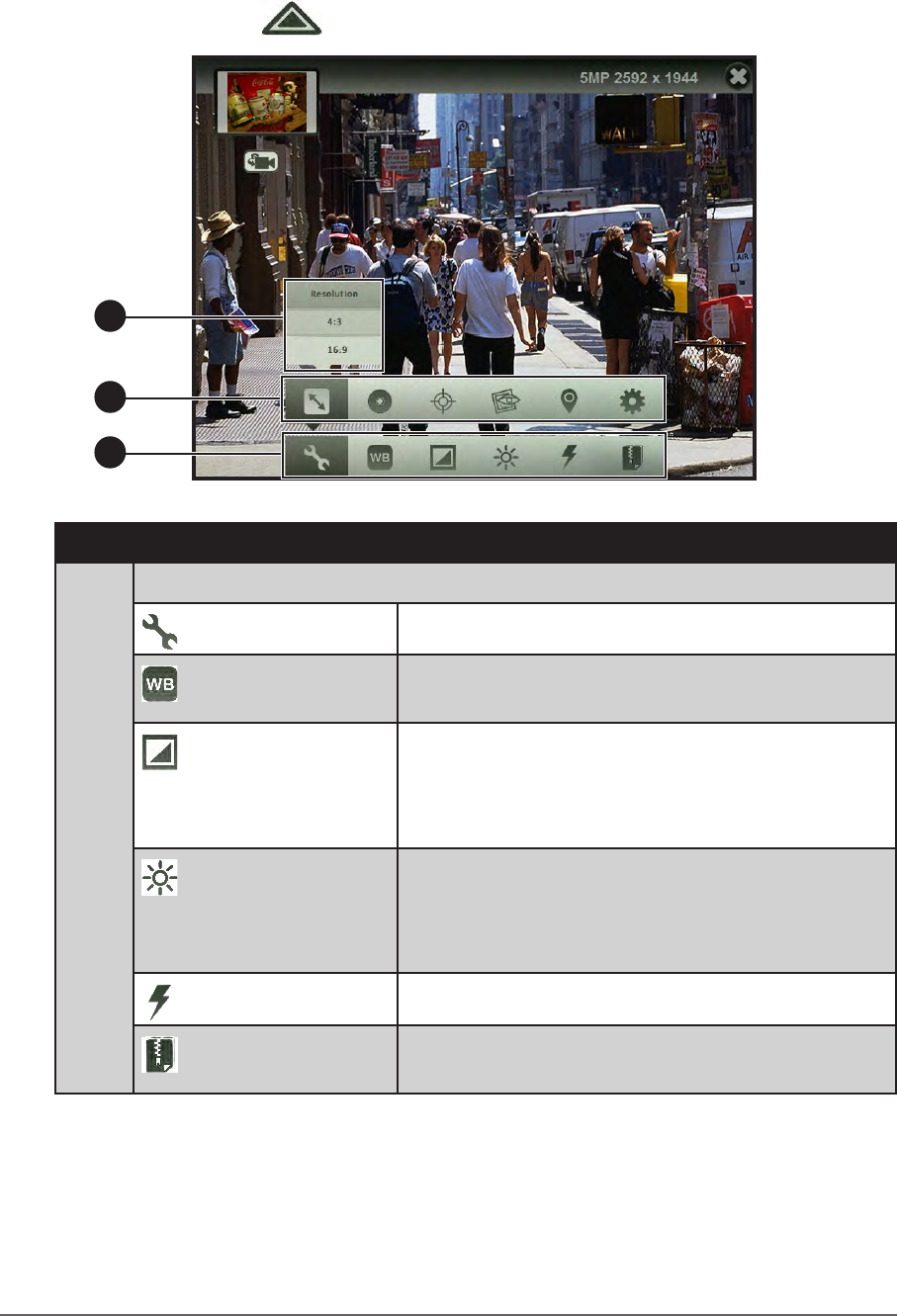
2-32 Operating Your Tablet Computer
Working With Photos
The Photo Menu
In Photo mode, tap to access the photo menu settings.
2
1
3
No. Item Description
1Main Photo Menu
More Settings Tap to expand the menu. See item number 2.
White Balance Tap to set the white balance setting. See “To
set the white balance” on page 2-33.
Exposure Tap to select an exposure value. Select
“Auto” to allow the camera to automatically
set the exposure based on the surrounding
light.
Brightness Tap to set the brightness setting. The higher
the value, the brighter the capture setting
becomes. Select “0” for normal brightness
setting.
Flash Turns the ash on or off.
Image Quality Sets the image quality setting. See “To set
the image quality” on page 2-34
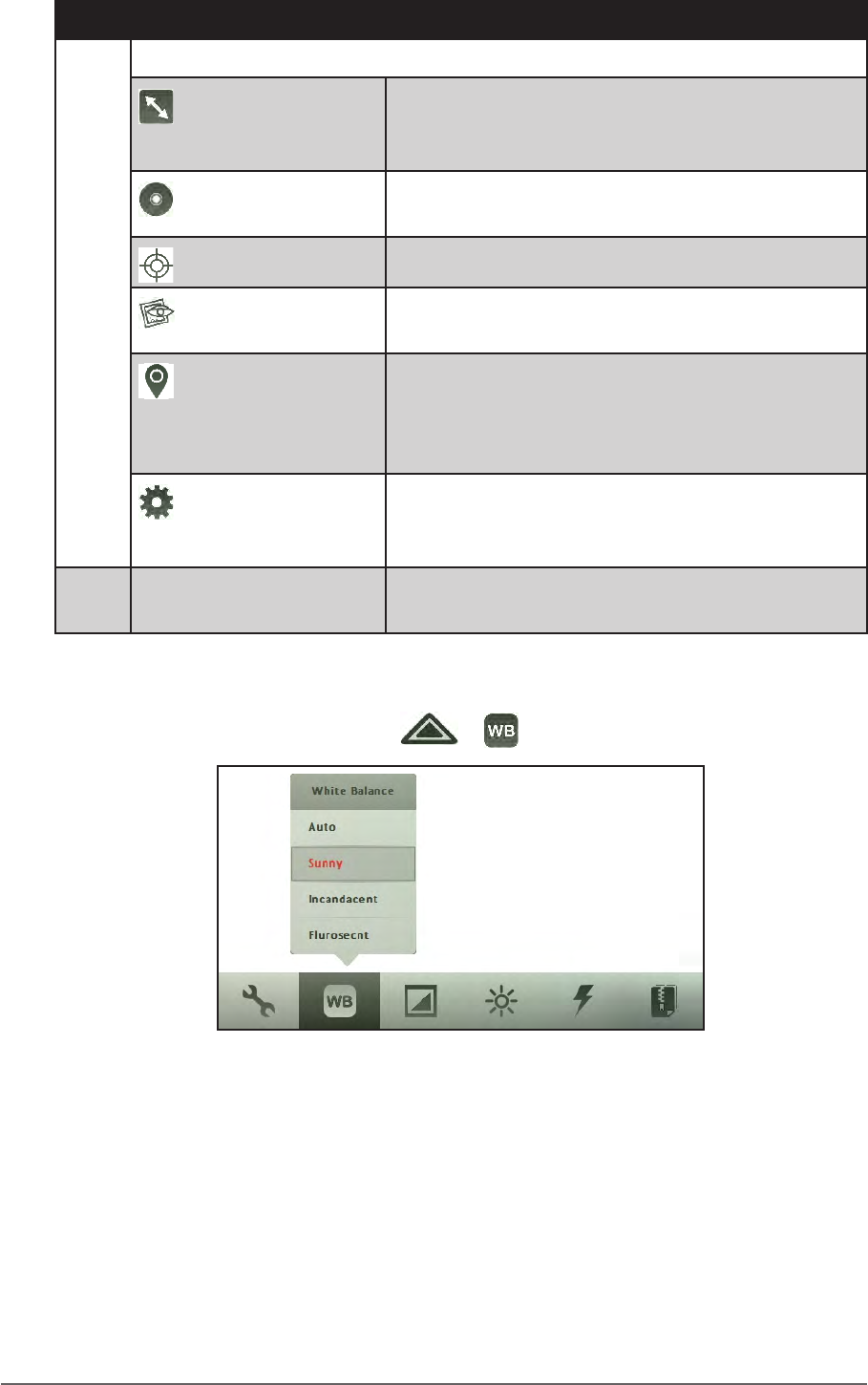
2-33Operating Your Tablet Computer
No. Item Description
2Expanded Photo Menu
Aspect Ratio and
Resolution
Sets the aspect ratio and resolution.
See “To set the aspect ratio and resolution”
on page 2-34.
Storage Location Sets either Internal Memory or External
Memory to save captured photos or videos.
Focus Enables or disables focus.
Image Review Congures the image review options. See “To
preview photos” on page 2-35.
Image Tagging Adds date or GPS tags to captured photos.
See “To add date and time on photos” on
page 2-36 and “To tag photos with GPS” on
page 2-37.
App Settings Congures the camera orientation, sound
setting, and lename prex. See “Managing
Camera Application Settings” on page 2-42.
3Submenu Options Displays the options of a tapped menu. Tap
an option to select it.
To set the white balance
1. In Photo or Video mode, tap > .
2. Tap the one of the following options:
• Auto: Allows the camera to set the white balance automatically.
• Sunny: Select this option when capturing outdoor photos.
• Incandescent: Select this option when capturing indoor photos.
• Fluorescent: Select this option when capturing photos under
uorescent lighting.
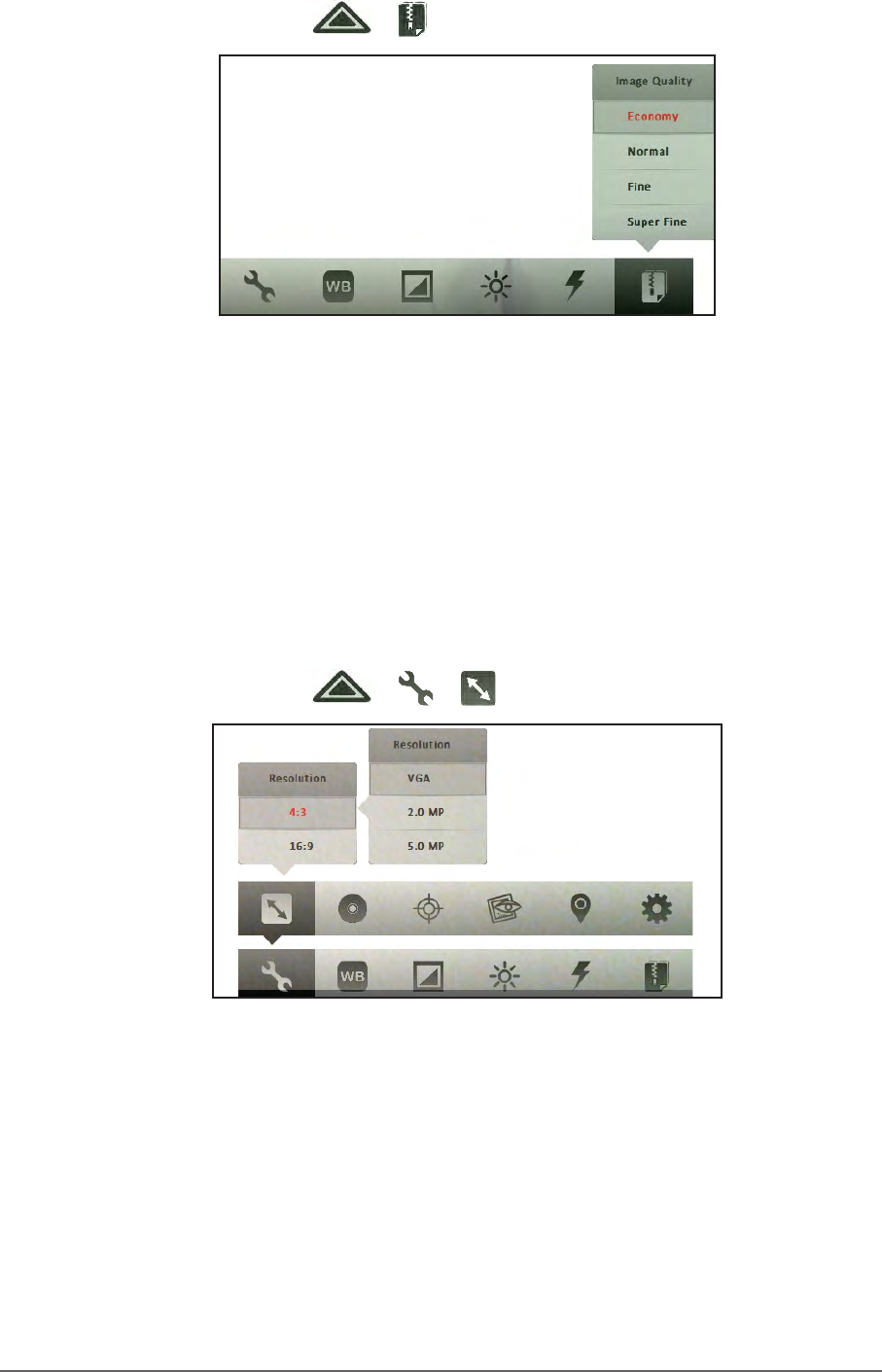
2-34 Operating Your Tablet Computer
To set the image quality
1. In Photo mode, tap > .
2. Tap one of the following options:
• Economy: Select this option to capture small-sized photos to
conveniently attach in emails or messages.
• Normal: Select this option for normal image quality.
• Fine: Select this option for better image quality.
• Super Fine: Select this option for the best image quality. The le size is
bigger than lower quality images.
To set the aspect ratio and resolution
1. In Photo mode, tap > > .
2. Tap an aspect ratio option:
• 4:3: Select this option for a 4:3 ratio photo.
• 16:9: Select this option for a 16:9 ratio photo.
3. Tap a resolution. The available options depend on the selected aspect
ratio.
• For 4:3 aspect ratio, the following options are available:
• VGA: Select this option for a 640 x 480 resolution.
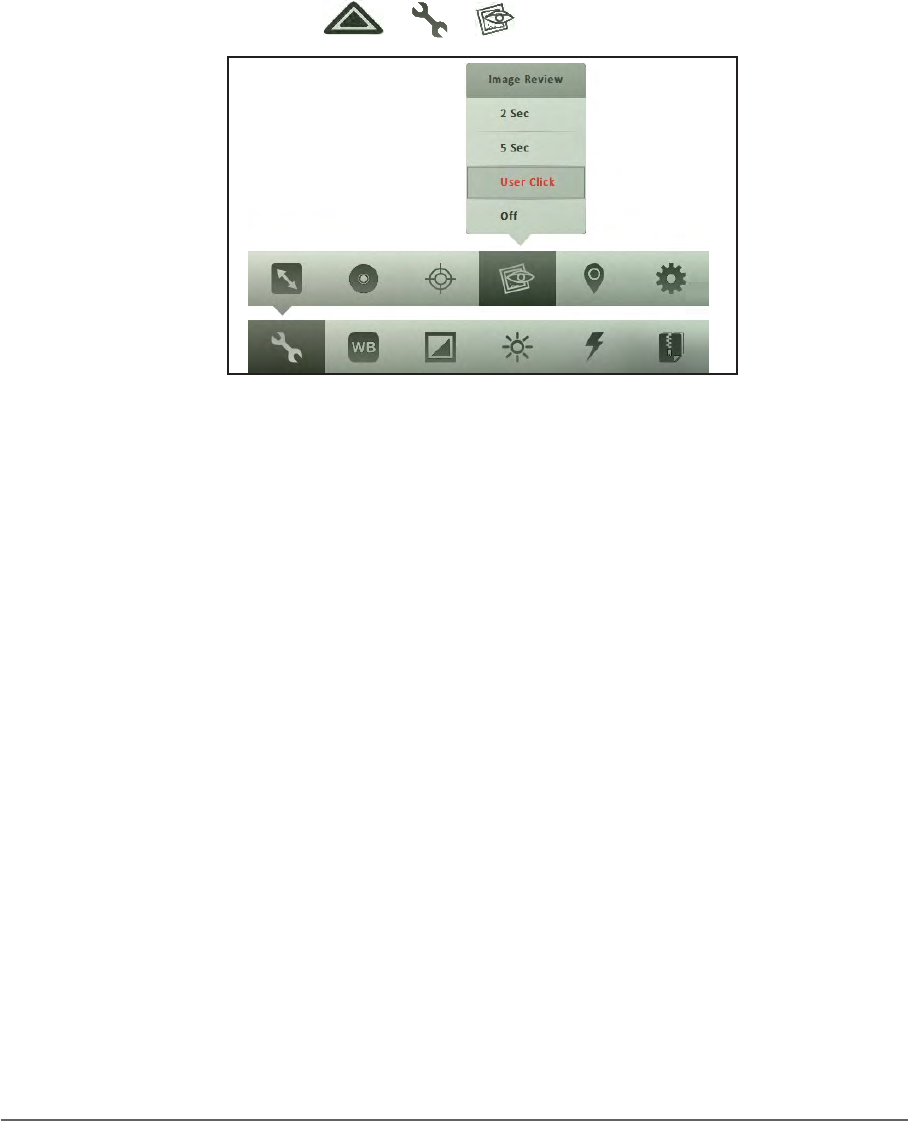
2-35Operating Your Tablet Computer
• 2.0 MP: Select this option for a 1600 x 1200 resolution.
• 5.0 MP: Select this option for a 2592 x 1944 resolution.
• For 16:9 aspect ratio, the following options are available:
• 1.0 MP: Select this option for a 1280 x 720 resolution.
• 3.0 MP: Select this option for a 1920 x 1080 resolution.
To preview photos
The Image Review setting allows you to preview captured photos right after
shooting it.
1. In Photo mode, tap > > .
2. Tap one of the following options:
• 2 Sec: Select this option to display the photo for 2 seconds after
capturing it.
• 5 Sec: Select this option to display the photo for 5 seconds after
capturing it.
• User Click: Select this option to display the photo right after capturing
it and closes the preview when the user taps the screen.
• Off: Select this option to disable photo preview.
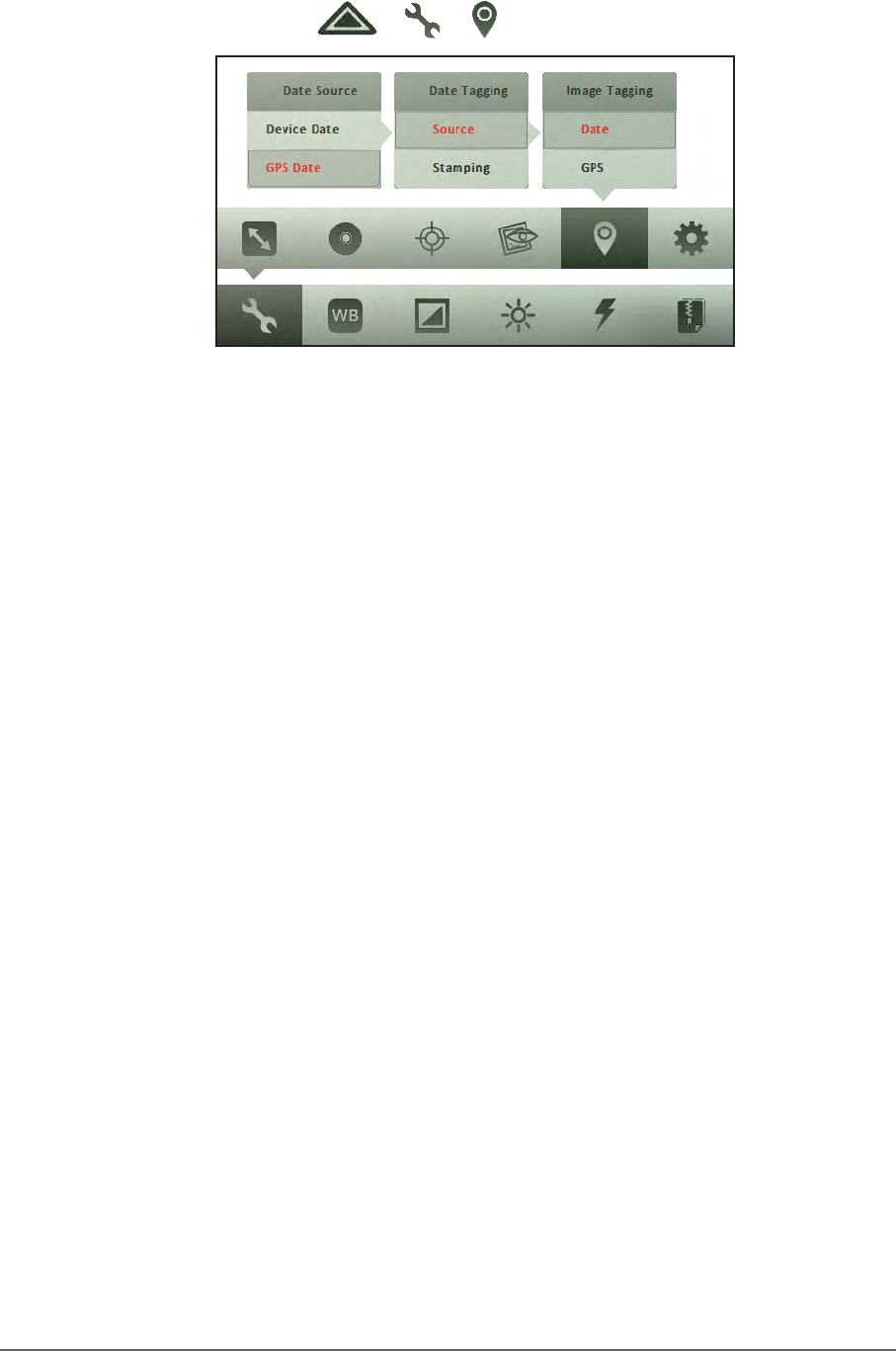
2-36 Operating Your Tablet Computer
To add date and time on photos
Perform the following to add the date and time on photos.
1. In Photo mode, tap > > .
2. Tap Date.
3. Tap Source, and then tap one of the following options:
• Device Date: Select this option to use the date and time of your Tablet
Computer.
• GPS Date: Select this option to use the date and time of the GPS
navigation system.
4. Tap Stamping, and then tap one of the following options:
• Image Stamp: Select this option to add the date and time on captured
photos.
• Exif: Select this option to save the date and time to the exif data of the
captured photo. The date and time is not shown on the screen nor on
printed photos.
• Both: Select this option to add the date and time on captured photos
and save it on the exif data.
• Off: Select this option to hide the date and time.
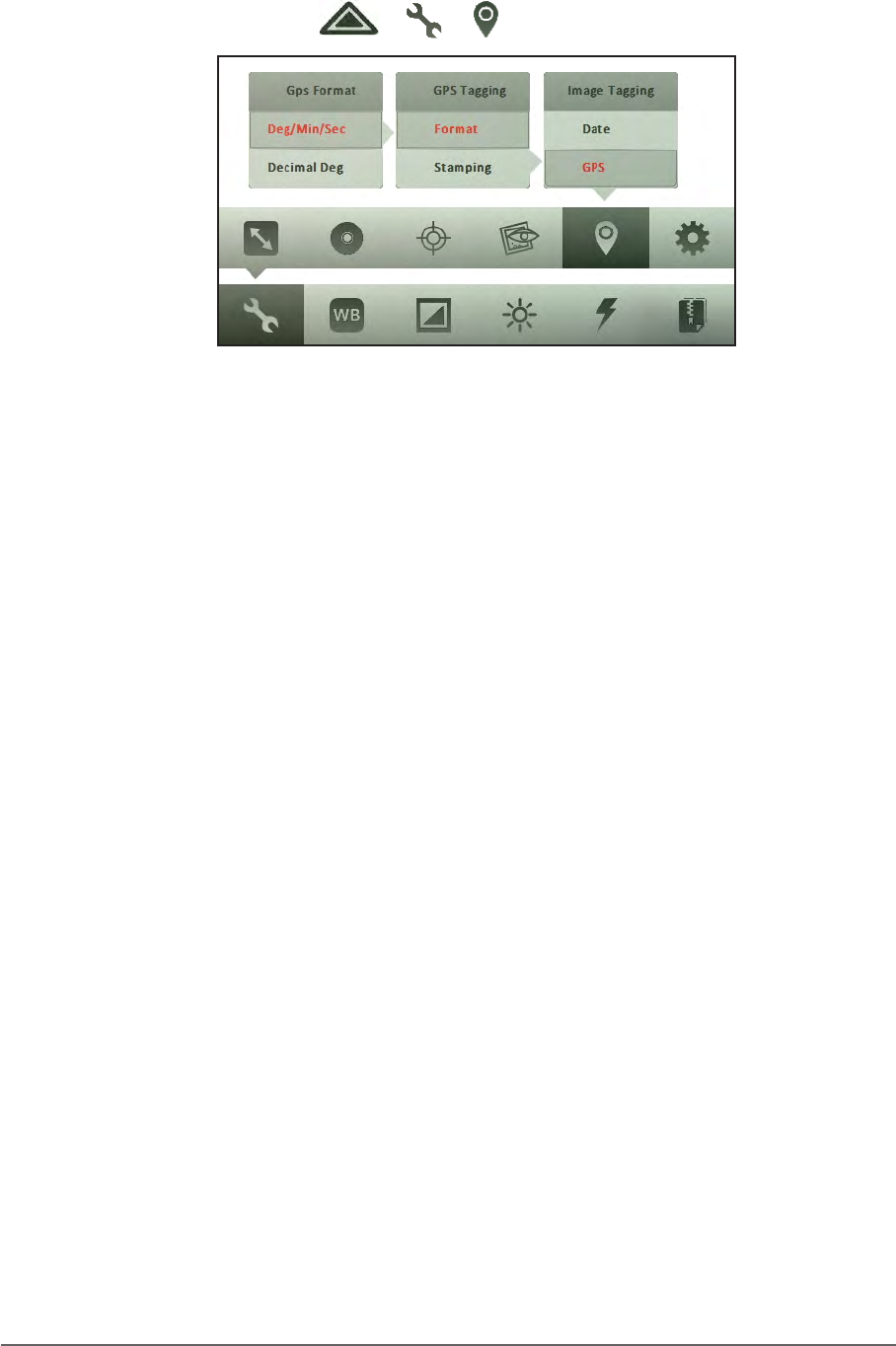
2-37Operating Your Tablet Computer
To tag photos with GPS
Perform the following to tag photos with GPS location.
1. In Photo mode, tap > > .
2. Tap GPS.
3. Tap Format, and then tap one of the following options:
• Deg/Min/Sec: Select this option to tag and display the GPS location in
Deg/Min/Sec format.
• Decimal Deg: Select this option to tag and display the GPS location in
decimal degree format.
4. Tap Stamping, and then tap one of the following options:
• Image Stamp: Select this option to tag and add the GPS location on
captured photos.
• Exif: Select this option to tag and save the GPS location to the exif
data of the captured photo. The GPS location is not shown on the
screen nor on printed photos.
• Both: Select this option to tag and display the GPS location on
captured photos and save the location on the exif data.
• Off: Select this option to hide the GPS location.
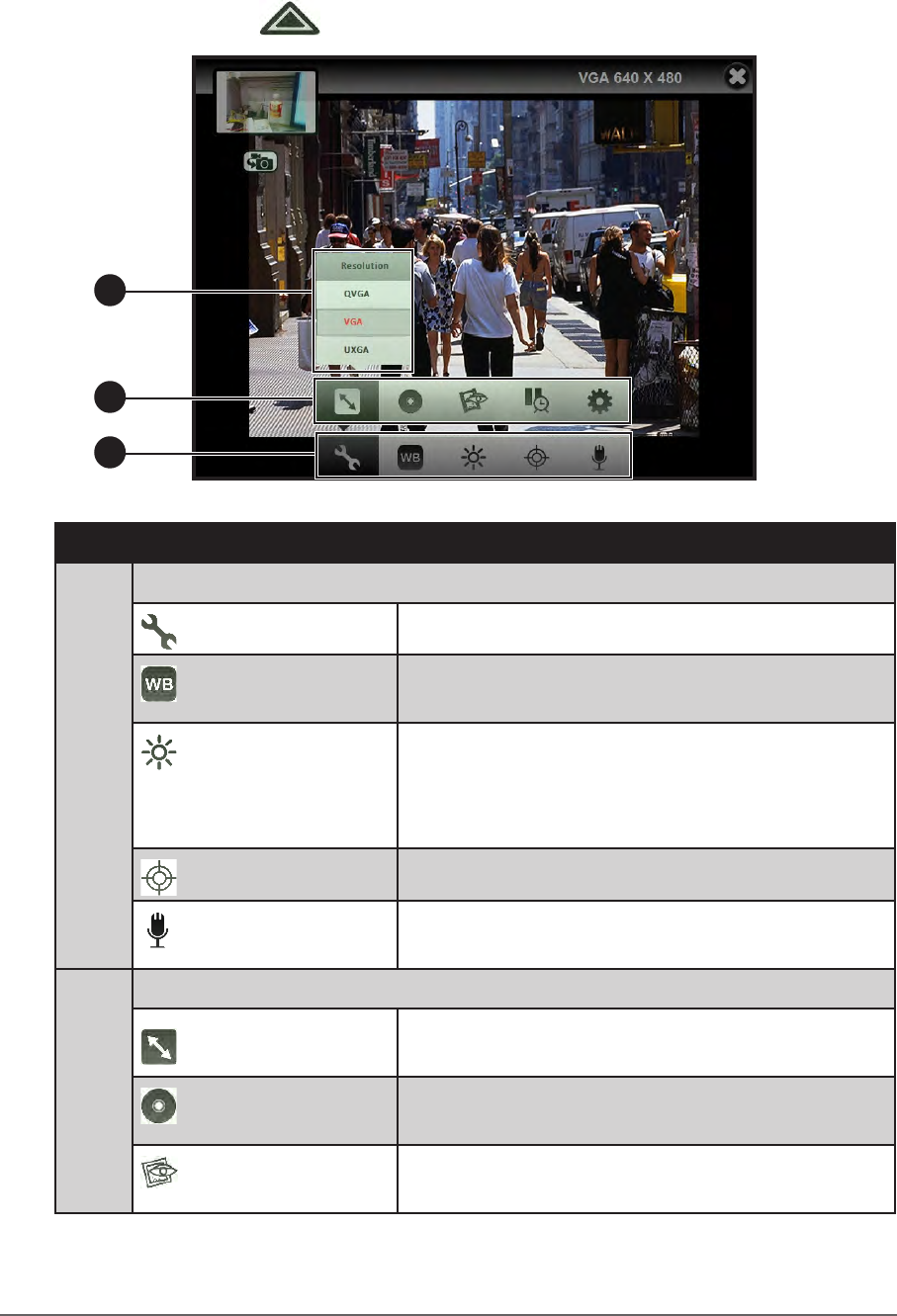
2-38 Operating Your Tablet Computer
Working with Videos
The Video Menu
In Video mode, tap to access the video menu settings.
2
1
3
No. Item Description
1Main Video Menu
More Settings Tap to expand the menu. See item number 2.
White Balance Tap to set the white balance setting. See “To
set the white balance” on page 2-39.
Brightness Tap to set the brightness setting. The higher
the value, the brighter the capture setting
becomes. Select “0” for normal brightness
setting.
Focus Enables or disables focus.
Audio Record Enables or disables audio recording. See “To
enable audio recording” on page 2-39.
2Expanded Video Menu
Resolution Sets the video resolution. See “To set the
video resolution” on page 2-40.
Storage Location Sets either Internal Memory or External
Memory to save captured videos.
Video Review Congures the video review options. See “To
enable video review” on page 2-40.
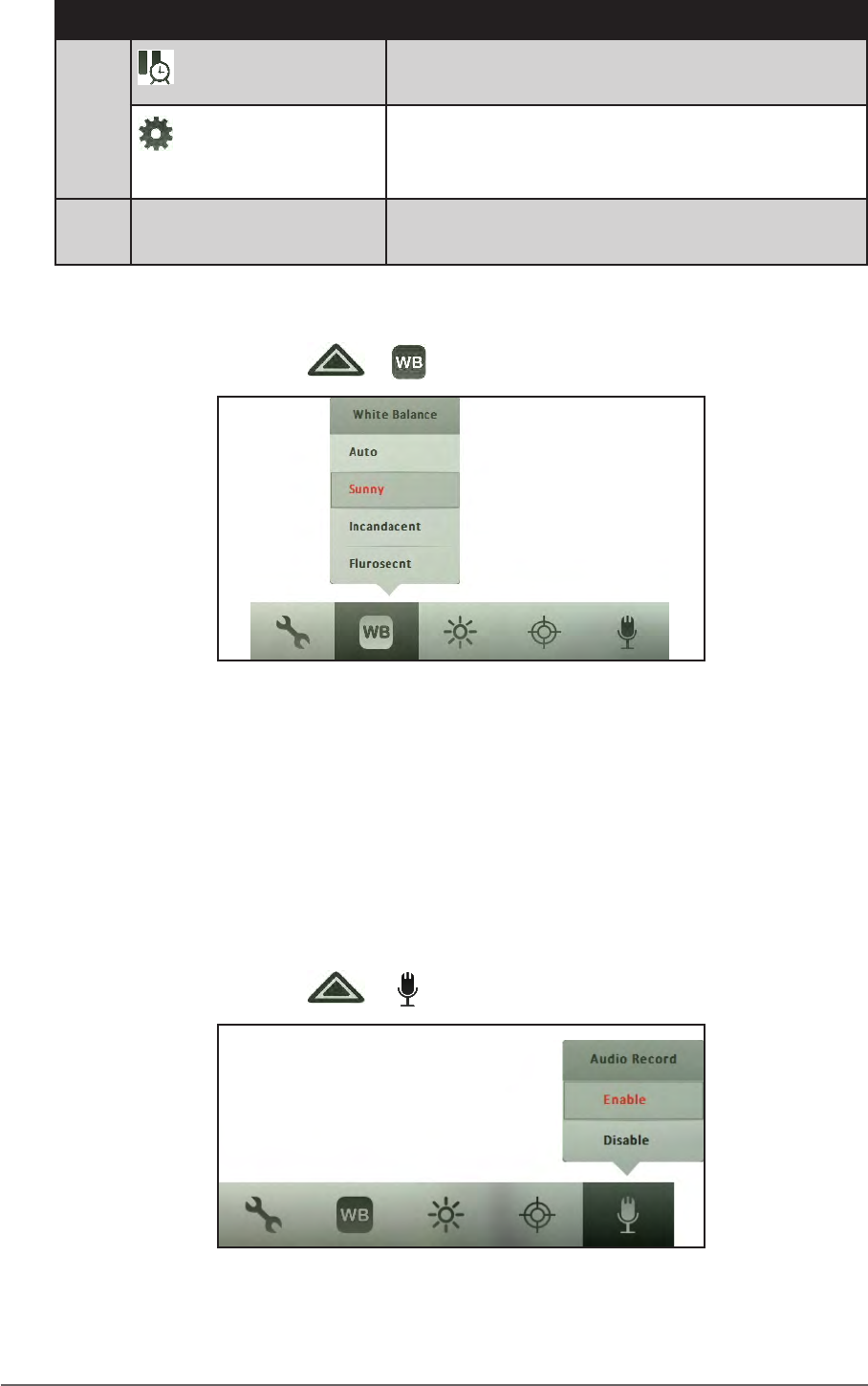
2-39Operating Your Tablet Computer
No. Item Description
2 Pause Timeout Sets the pause timeout option. See “To set
pause timeout” on page 2-41.
App Settings Congures the sound and lename prex
settings. See “Managing Camera Application
Settings” on page 2-42.
3Submenu Options Displays the options of a tapped menu. Tap
an option to select it.
To set the white balance
1. In Video mode, tap > .
2. Tap the one of the following options:
• Auto: Allows the camera to set the white balance automatically.
• Sunny: Select this option when capturing outdoor videos.
• Incandescent: Select this option when capturing indoor videos.
• Fluorescent: Select this option when capturing videos under
uorescent lighting.
To enable audio recording
1. In Video mode, tap > .
2. Tap Enable to enable audio recording or Disable to disable audio
recording.
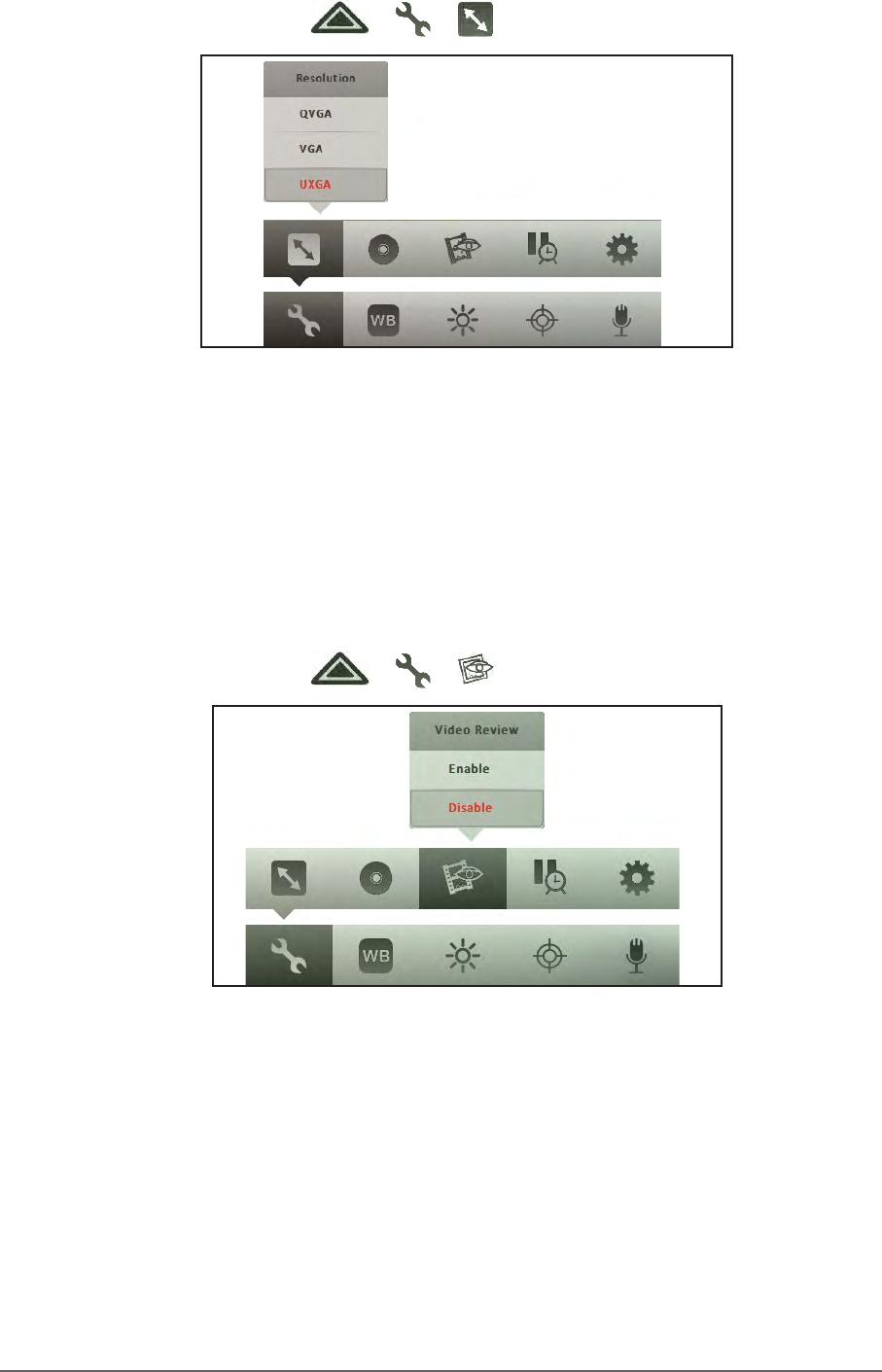
2-40 Operating Your Tablet Computer
To set the video resolution
1. In Video mode, tap > > .
2. Tap a resolution.
• QVGA: Select this option for a 320 x 240 video resolution. Ideal for
recording small-sized videos to attach to emails or messages.
• VGA: Select this option for a 640 x 480 video resolution.
• UXGA: Select this option for a 2600 x 1200 video resolution. Ideal for
recording high quality videos.
To enable video review
1. In Video mode, tap > > .
2. Tap one of the following options:
• Enable: Select this option to review the video right after recording it.
• Disable: Select this option to disable video review.
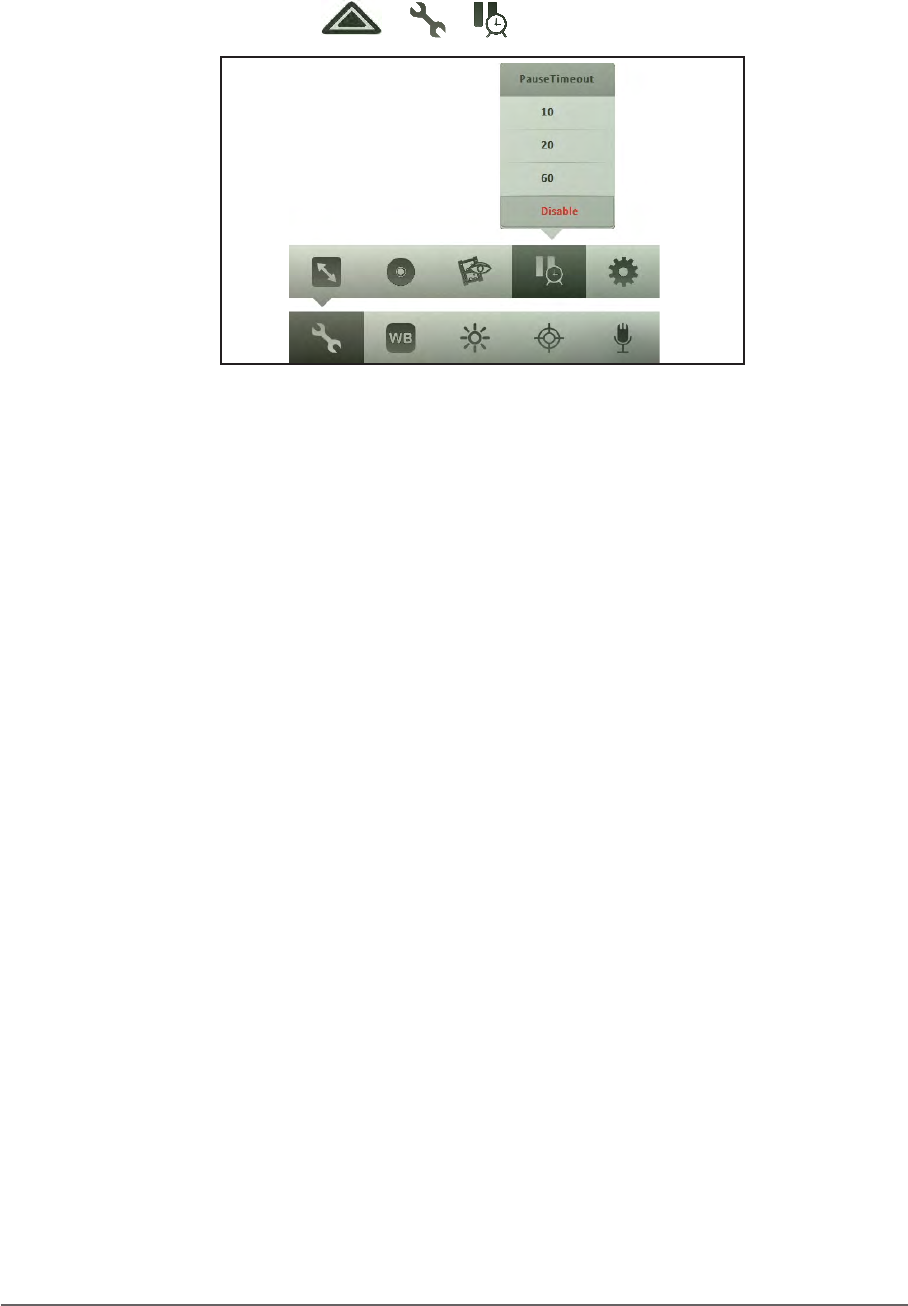
2-41Operating Your Tablet Computer
To set pause timeout
When recording videos, users sometimes pause the recording and forget to
resume or stop it. With the Pause Timeout setting, you can set the amount of
time after which the paused recording is automatically saved and stopped.
1. In Video mode, tap > > .
2. Tap one of the following options:
• 10: Select this option to save and stop the recording after being paused
for 10 seconds.
• 20: Select this option to save and stop the recording after being paused
for 20 seconds.
• 60: Select this option to save and stop the recording after being paused
for 60 seconds.
• Disable: Select this option to disable pause timeout option.
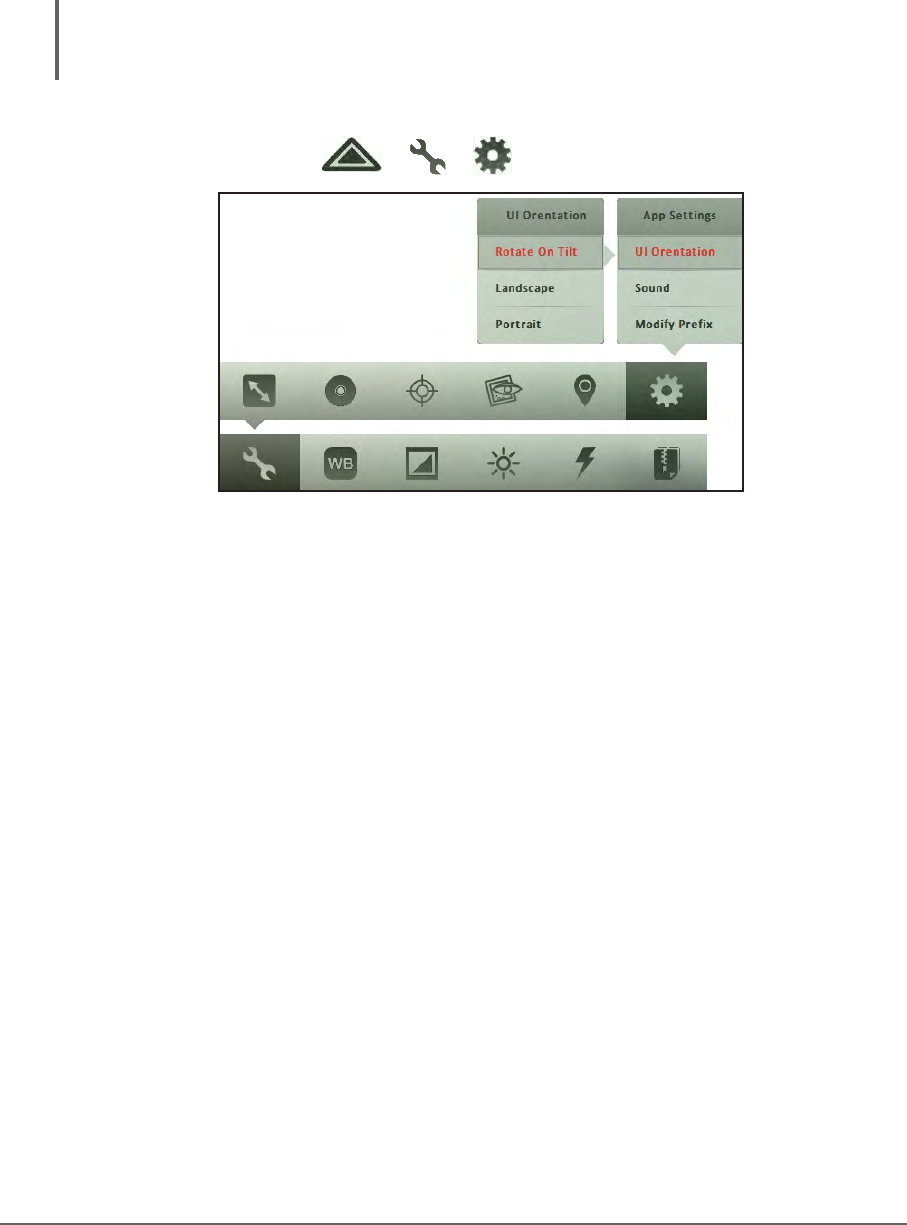
2-42 Operating Your Tablet Computer
Managing Camera Application Settings
To change the screen orientation
The camera screen orientation can be xed to portrait or landscape mode or
make the screen automatically change orientation as you rotate the Tablet
Computer.
NOTE: This feature is available only in Photo mode. In Video mode, the screen orientation is
automatically set to landscape mode.
Perform the following to set the camera screen orientation.
1. In Photo mode, tap > > .
2. Tap UI Orientation.
3. Tap one of the following options:
• Rotate on Tilt: Select this option to change the screen orientation as
you rotate the Tablet Computer.
• Landscape: Select this option to x the screen orientation to landscape
mode.
• Portrait: Select this option to x the screen orientation to portrait mode.
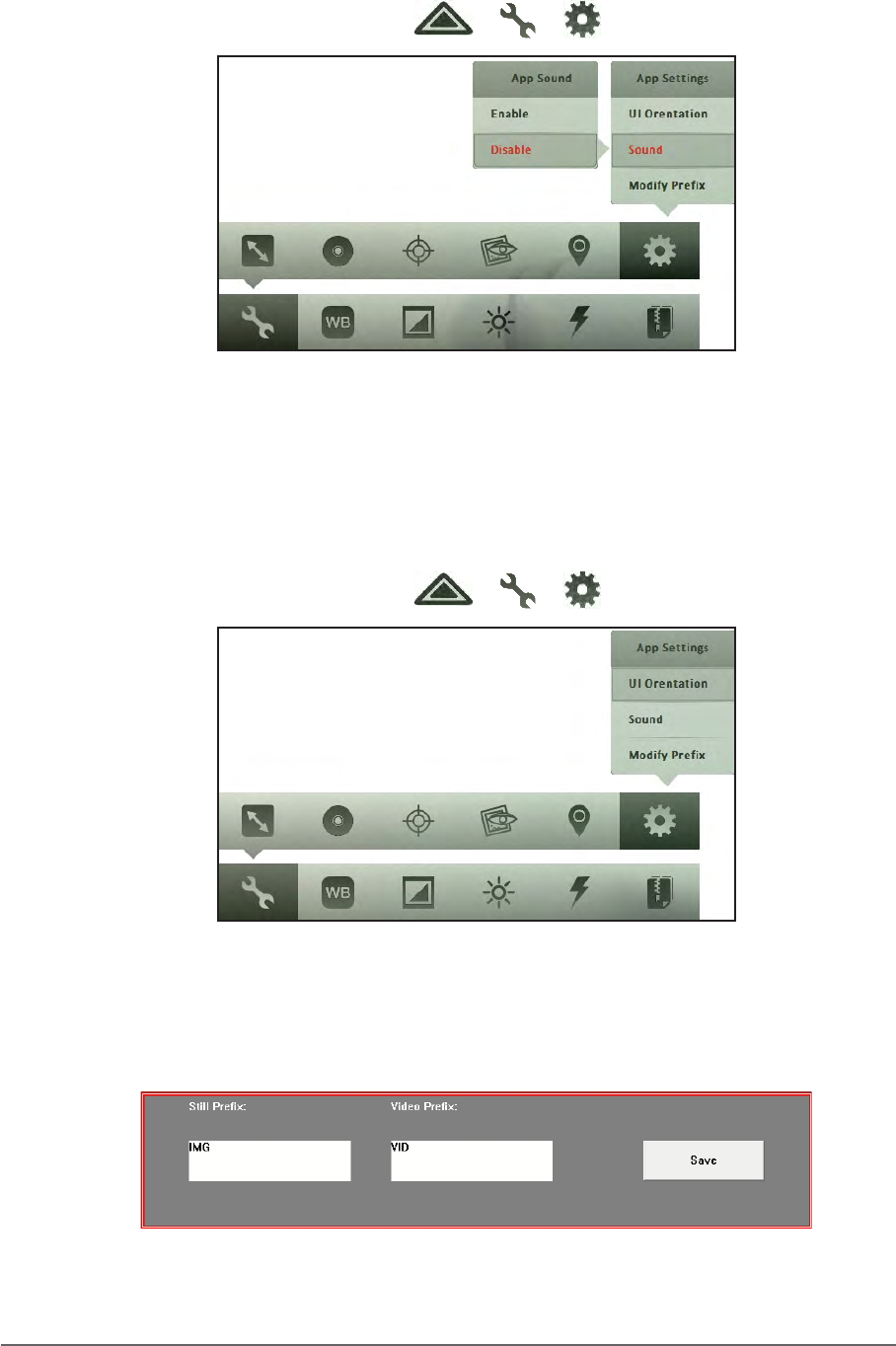
2-43Operating Your Tablet Computer
To enable sound
Perform the following to enable or disable the camera sound.
1. In Photo or Video mode, tap > > .
2. Tap Sound.
3. Tap Enable or Disable.
To modifying lename prex
Perform the following to specify the prex of photo and video lenames.
1. In Photo or Video mode, tap > > .
2. Tap Modify Prex.
3. On the Still Prex box, type the desired prex to add to photo lenames.
4. On the Video Prex box, type the desired prex to add to video lenames.
5. Tap Save to save changes.

3-1Expanding Your Tablet Computer
CHAPTER 3
You can expand the capabilities of your Tablet Computer by connecting other
peripheral devices. When using a device, be sure to read the instructions
accompanying the device together with the relevant section in this chapter.
This chapter gives guidelines on installing and using these devices:
• USB Device
• HDMI Device
• Audio Device
Expanding Your Tablet
Computer
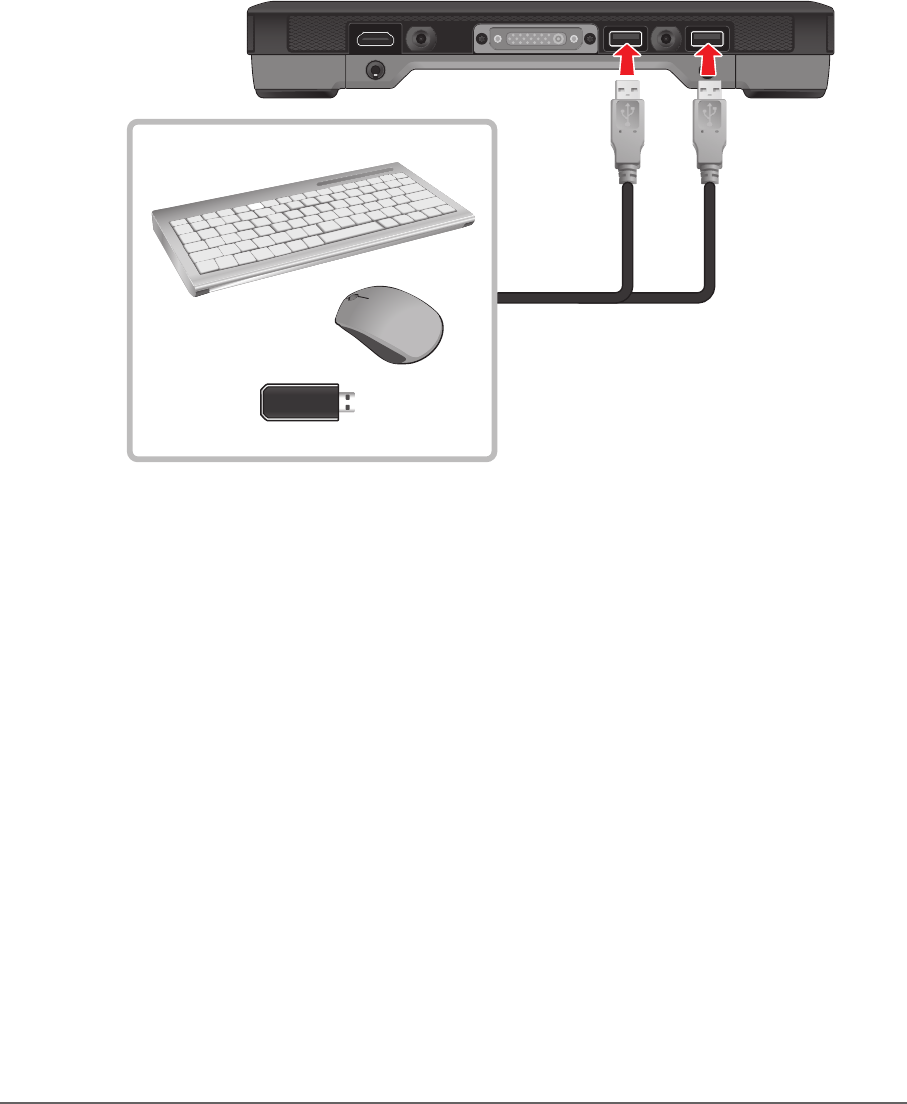
3-2 Expanding Your Tablet Computer
Connecting USB Devices
Your Tablet Computer has two USB ports for connecting USB devices, such as
a ash disk drive, scanner, printer, keyboard, and mouse. The Tablet Computer
has built-in support for mass storage devices and human interface devices.
Other types of USB devices may require drivers.
To connect a USB device, simply plug the device cable into one of the USB
ports of your Tablet Computer.
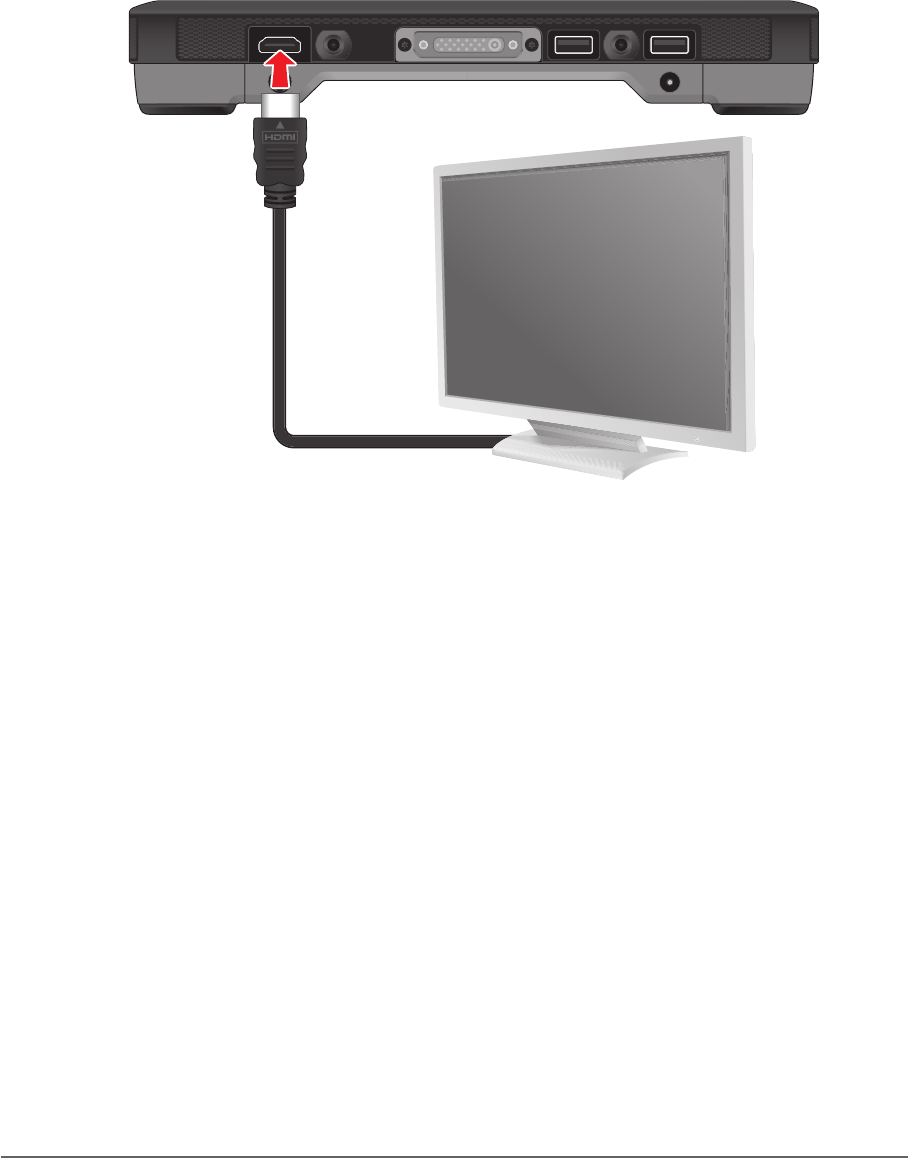
3-3Expanding Your Tablet Computer
Connecting HDMI Devices
Your Tablet Computer has one HDMI port for connecting HDMI devices, such as
an external monitor.
To connect an HDMI device, simply plug the device cable into the HDMI
connector of your Tablet Computer.
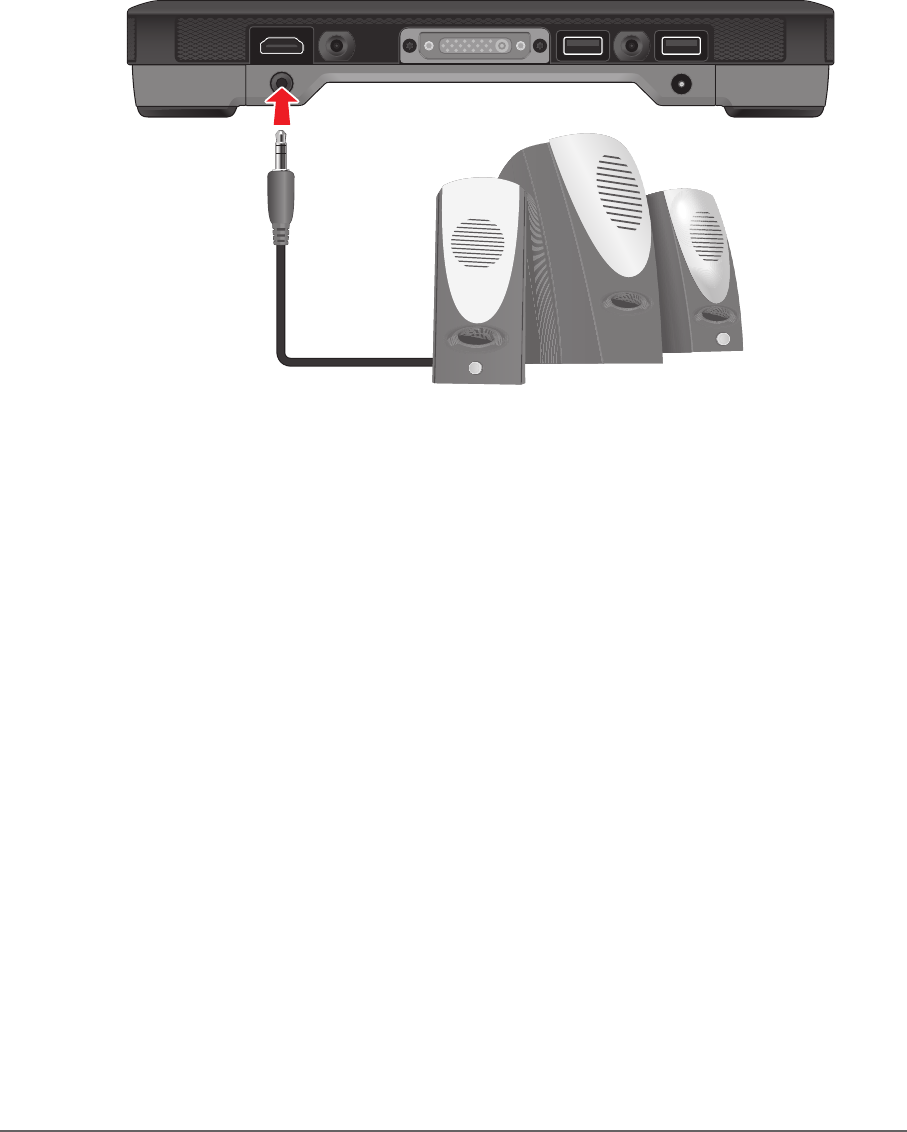
3-4 Expanding Your Tablet Computer
Connecting Audio Devices
Your Tablet Computer has one combo audio connector that supports both audio
in and audio out devices. You can connect speakers, headphones, or earphone
set.
To connect an audio device, simply plug the device cable into the audio
connector of your Tablet Computer.

4-1Managing Power
CHAPTER 4
Your Tablet Computer operates either on external AC power or on battery
power.
This chapter tells you how you can effectively manage power. To maintain
optimal battery performance, it is important that you use the battery in the
proper way.
The topics in this chapter include:
• How to charge the battery pack
• How to check the battery level
• What happens when the battery is low and what actions to take
• What is Power Management
• How to save power
Managing Power
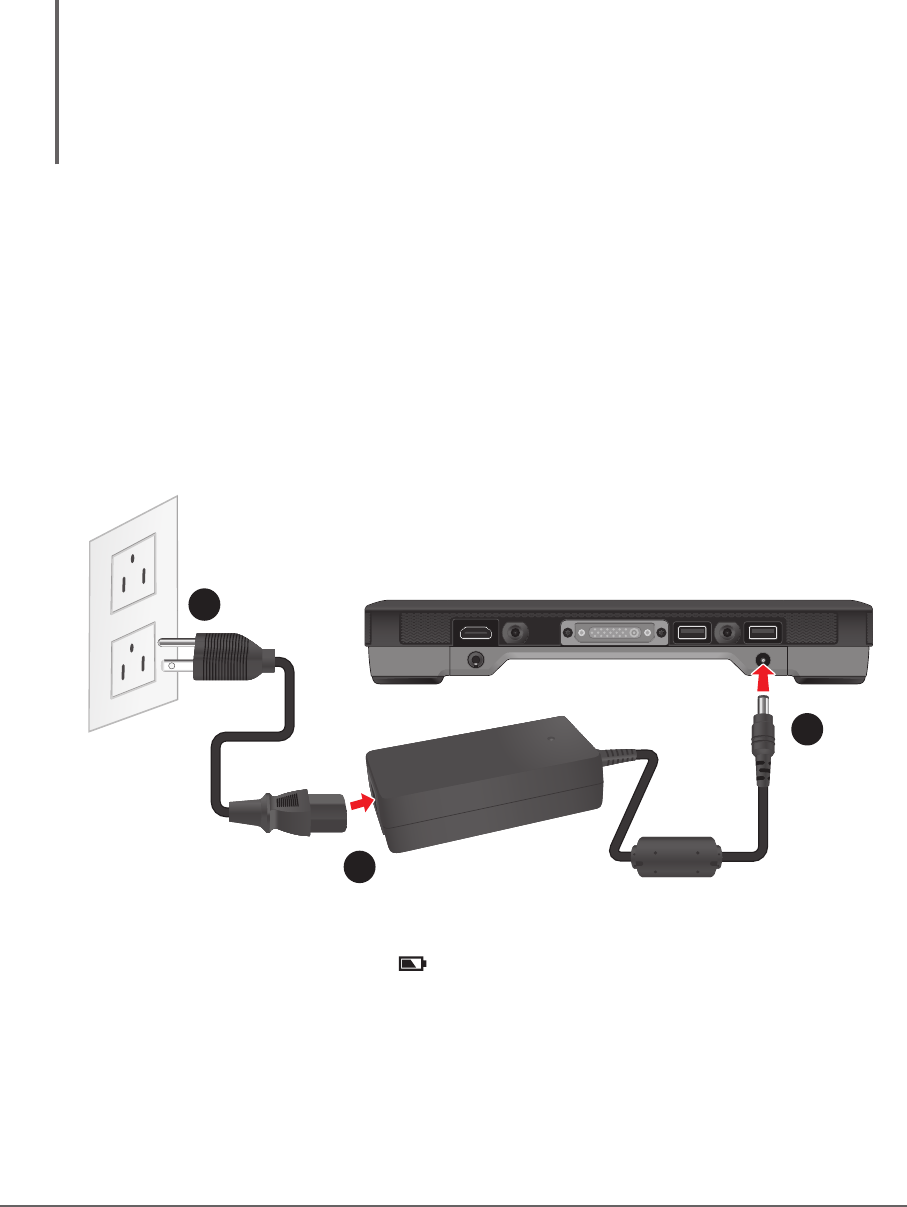
4-2 Managing Power
Battery Pack
The operating time of a fully charged battery pack depends on how you use
the Tablet Computer. When you use applications that often access peripherals,
or when you stay connected to a wireless network, the operating time of the
battery may be shortened.
WARNING:
• Do not disassemble the battery pack. There are no user-serviceable parts inside. Doing so
may present risk of exposure to harmful chemicals, explosion or re.
• Contact your local waste disposal service provider regarding the disposal or recycling of used
battery packs.
Charging the Battery Pack
To charge the battery packs, perform the following:
1. With the battery packs installed, plug the DC cord of the AC adapter into
the power connector of the tablet computer.
2. Plug the female end of the AC power cord into the AC adapter.
3. Then plug the male end of the AC power cord into an electrical outlet.
1
2
3
The battery LED indicator ( ) glows amber to indicate that charging is
in progress. When the battery is fully charged, the battery LED indicator
glows green.
The Tablet Computer charges one battery pack at a time. After the rst
battery is full, it charges the second battery pack.

4-3Managing Power
Checking the Battery Level
To check the battery level, press the battery button on each of the battery
packs. The battery LED lights up. The number of lit up LEDs indicate the battery
level of the battery pack.
NOTE: The battery capacity indicator shows only the battery level of one battery pack. To check the
level of the second battery pack, press the battery button on the second battery pack.
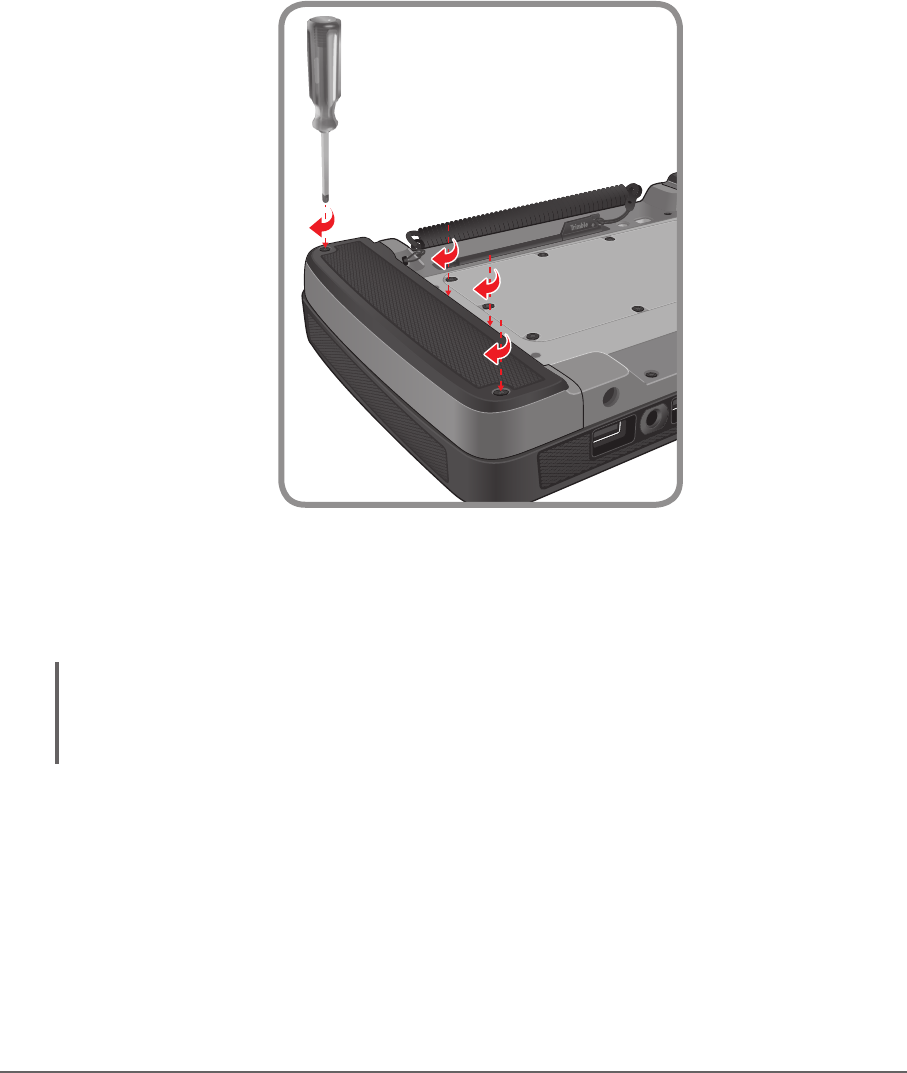
4-4 Managing Power
Replacing the Battery Pack
If you rely on battery power for a long period of time, consider purchasing
extended life batteries or an additional set of standard batteries from your
dealer to use for backup.
To replace the battery pack, perform the following:
1. Shut down the Tablet Computer.
2. Disconnect the Tablet Computer from the AC power.
3. Using a Phillips #1 screwdriver, loosen the four screws securing the
battery pack and then lift out the battery.
4. Fit the replacement battery pack in place and secure the four screws. Do
not over tighten.
5. Repeat the above steps to replace the other battery pack as needed.
NOTE: You can still operate the Tablet Computer on one battery while replacing the other battery
pack. Operating one battery for an extended period is not recommended as an empty battery pack
slot exposes the Tablet Computer internal parts to environmental hazards, such as dust and water.

4-5Managing Power
Power Management
The power management feature helps reduce power consumption extending
battery life.
Your Tablet Computer supports ACPI (Advanced Conguration and Power
Interface) for power management. Power supply to different components is
controlled on an as-needed basis. This allows maximum power conservation
and performance at the same time.
Windows comes with pre-dened Power Options (Balanced, Power Saver,
and High Performance) for you to select. You can access Power Options
by tapping Start > Control Panel > Power Options. By default, your Tablet
Computer is in Balanced Mode.
For detailed information on power management, see Windows Help.

4-6 Managing Power
Power Saving Tips
Here are some practical suggestions that you can do to maximize the operating
time of the battery:
• Enable Power Management. Choose a power plan that saves power. A
power plan is a collection of hardware and system settings that control how
your Tablet Computer manages power.
• Decrease the LCD brightness to the lowest comfortable level.
• Shorten the length of time before Windows turns off the display.
• Many USB devices use power just by being connected. If you use a USB
ash drive, unplug it when you are not using it.
• Deactivate the Wireless LAN function if you are not using it.
• Deactivate Bluetooth wireless feature if you are not using it.
• Turn off the Tablet Computer when you are not using it.

5-1Using BIOS Setup and System Recovery
CHAPTER 5
BIOS Setup Utility is a program for conguring the BIOS (Basic Input/ Output
System) settings of the tablet computer. The BIOS is a layer of software,
called rmware, that translates instructions from other layers of software into
instructions that the tablet computer hardware can understand. The BIOS
settings are needed by your tablet computer to identify the types of installed
devices and establish special features.
System Recovery reinstalls Windows to your system and congures it to factory
default settings.
The chapter describes how to use the BIOS Setup and System Recovery.
Using BIOS Setup and
System Recovery
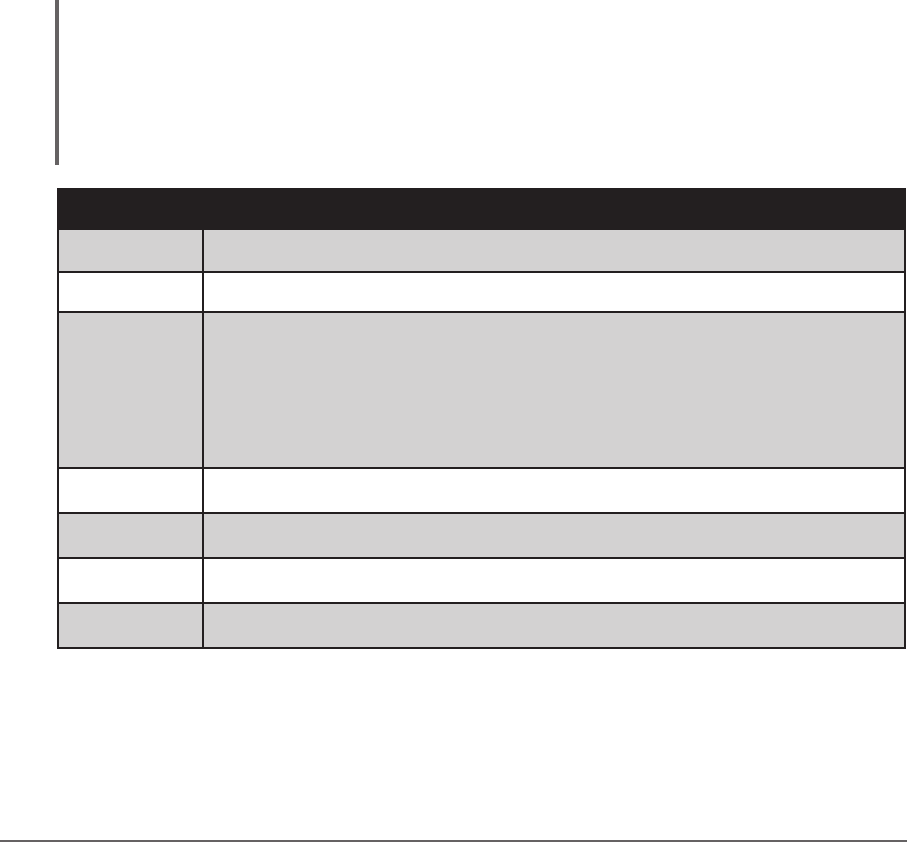
5-2 Using BIOS Setup and System Recovery
BIOS Setup
When to Use
You need to run BIOS Setup utility when:
• You see an error message on the screen requesting that you run BIOS
Setup utility.
• You want to restore the factory default BIOS settings.
• You want to modify some specic hardware settings.
• You want to modify some specic settings to optimize the system
performance.
How to Use
To run BIOS Setup Utility, press the Fn key when the Trimble logo appears on
the screen during system startup.
NOTE:
• The BIOS Setup Utility screens shown in this chapter are for reference only. The actual items
or settings on your Tablet Computer may differ.
• The settings you select in your operating system might override similar settings in BIOS Setup
Utility.
Key Function
◄ / ► Selects a menu title.
▲ / ▼ Selects an item or option.
OK • Brings up the submenu, if available
• When an item is selected, opens or closes the options
window
• Goes to the next eld when an item has multiple elds, such
as System Date.
F1 Displays help
F2 + Up Increases a value
F2 + Down Decreases a value
F3 Returns to the previous menu if in a submenu.
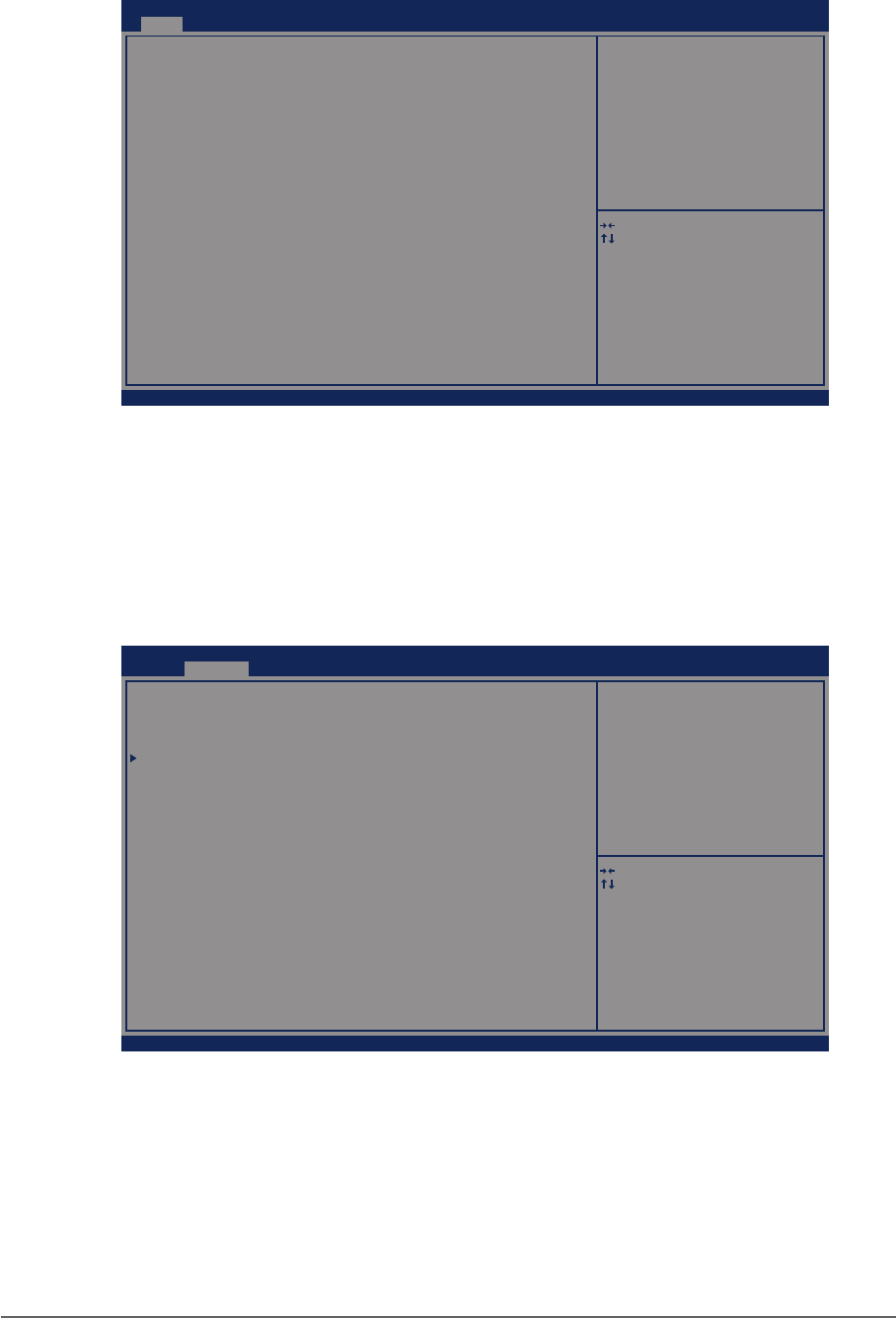
5-3Using BIOS Setup and System Recovery
Main Menu
The Main menu contains the system date and time settings and shows the
basic system information.
Main Advanced Boot Exit
Aptio Setup Utility - Copyright (C) 2011 American Megatrends, Inc.
Version 20.14.1219. Copyright (C) 2011 American Megatrends, Inc.
System Date [Thu 09/06/2012]
System Time [19:12:12]
Model No. XXXX
S/N No. xxxx-xxxx-xxxxxx
Processor Type Intel(R) Atom(TM) CPU
Processor Speed 1600 MHz
System Memory Size 2048 MB
System Storage Device 64GB SATA F1 (64GB)
Bios Revision X22
EC Revision X21
Set the Date. Use Tab Key to
switch between Date elements.
: Select Screen
: Select Item
Enter: Select
+/_:Change Opt.
F1: General Help
F2: Previous Values
F3: Optimized Defaults
F4: Save & Exit
ESC: Exit
• System Date: Sets the system date.
• System Time: Sets the system time.
Advanced Menu
The Advanced menu contains the advanced settings, such as GPS, LED, power
initiation, and TPM (Trusted Platform Module) settings.
Main AdvancedBoot Exit
Aptio Setup Utility - Copyright (C) 2011 American Megatrends, Inc.
Version 20.14.1219. Copyright (C) 2011 American Megatrends, Inc.
GPS Antenna [Built-in]
LED Indicator [Disable]
AC Initiation [Disable]
TPM
To switch GPS Antenna.
: Select Screen
: Select Item
Enter: Select
+/_:Change Opt.
F1: General Help
F2: Previous Values
F3: Optimized Defaults
F4: Save & Exit
ESC: Exit
• GPS Antenna: Selects the GPS Antenna.
• LED Indicator: Enables or disables the LED indicators.
• AC Initiation: Enables or disables the system to wake up while the AC
power is plugged in.
• TPM (Trusted Platform Module): Enables or disables support for security
devices.
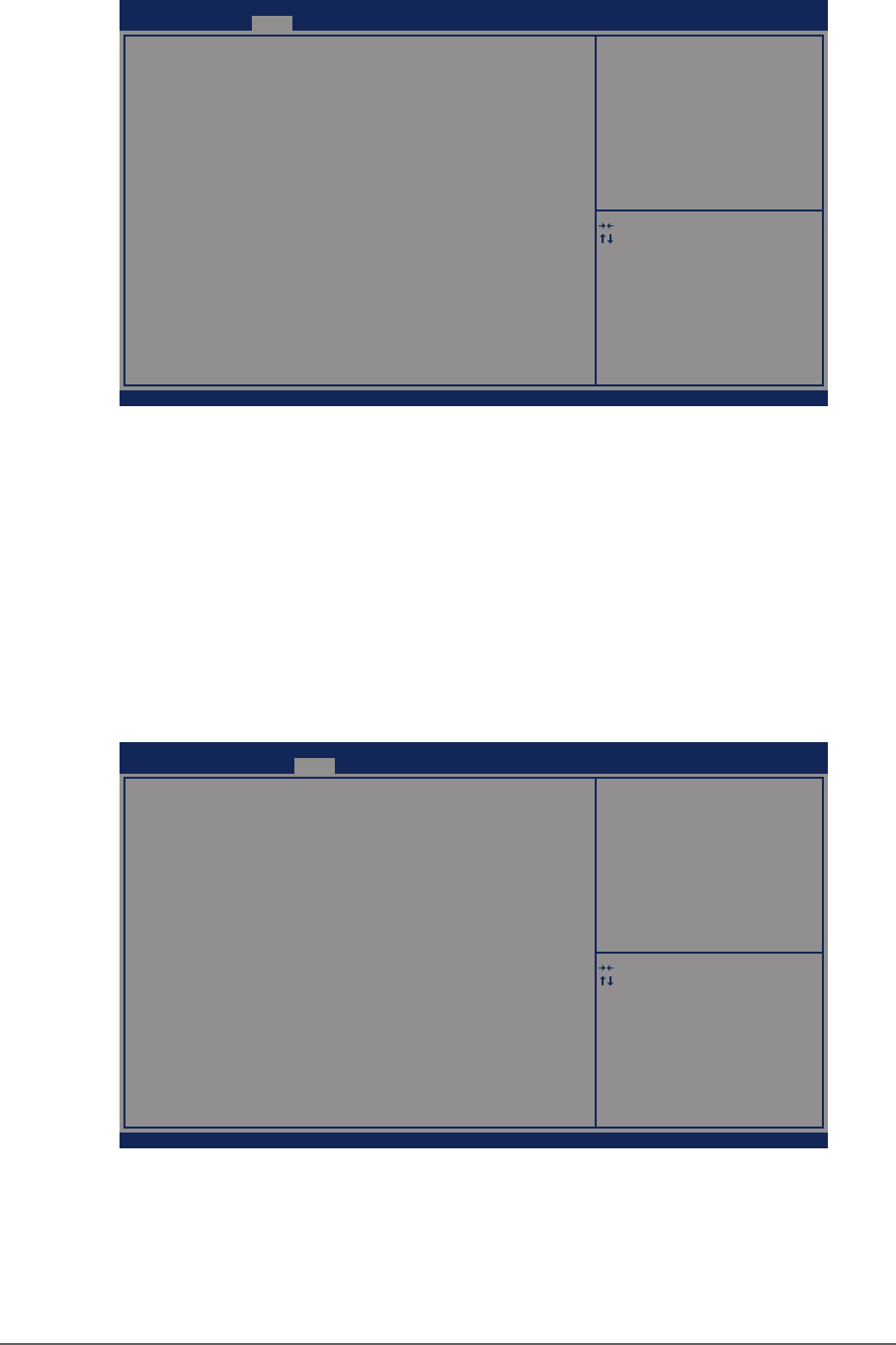
5-4 Using BIOS Setup and System Recovery
Boot Menu
The Boot menu sets the boot order of devices.
Main AdvancedBoot Exit
Aptio Setup Utility - Copyright (C) 2011 American Megatrends, Inc.
Version 20.14.1219. Copyright (C) 2011 American Megatrends, Inc.
Boot Option #1 [SATA PM:64GB SAT...]
Boot Option #2 [USB-to-Ethernet (L...]
Hard Drive BBS Priorities
BEV Device BBS Priorities
Set the system boot order.
: Select Screen
: Select Item
Enter: Select
+/_:Change Opt.
F1: General Help
F2: Previous Values
F3: Optimized Defaults
F4: Save & Exit
ESC: Exit
• Boot Option #1: Sets the rst device to boot.
• Boot Option #2: Sets the second device to boot.
• Hard Drive BBS Priorities: Sets the order of legacy devices in this group.
• BEV Device BBS Priorities: Sets the order of legacy devices in this group.
Exit Menu
The Exit menu displays ways of exiting BIOS Setup Utility. After modifying the
settings, you must save and exit for the changes to take effect.
Main AdvancedBootExit
Aptio Setup Utility - Copyright (C) 2011 American Megatrends, Inc.
Version 20.14.1219. Copyright (C) 2011 American Megatrends, Inc.
Exit Saving Changes
Exit Discrading Changes
Load Setup Defaults
Discard Changes
Save Changes
Reset the system after saving
the changes.
: Select Screen
: Select Item
Enter: Select
+/_:Change Opt.
F1: General Help
F2: Previous Values
F3: Optimized Defaults
F4: Save & Exit
ESC: Exit
• Exit Saving Changes: Saves the changes you have made and exits BIOS
Setup Utility.
• Exit Discarding Changes: Exits BIOS Setup Utility without saving the

5-5Using BIOS Setup and System Recovery
changes you have made.
• Load Setup Defaults: Restores the default values of all items.
• Discard Changes: Restores the previous values of all items.
• Save Changes: Saves the changes you have made.

6-1Caring for the Tablet Computer
CHAPTER 6
This chapter covers the following topics:
• How to care for your Tablet Computer
• Troubleshoot your Tablet Computer
Maintenance and
Troubleshooting

6-2 Caring for the Tablet Computer
Taking Care of the Tablet Computer
Location Guidelines
• Keep the tablet computer at least 13 cm (5 inches) away from electrical
appliances that can generate a strong magnetic eld such as a TV,
refrigerator, motor, or a large audio speaker.
General Guidelines
• Do not place heavy objects on top of the tablet computer as this may
damage the display.
• The screen surface is easily scratched. Use the screen protector lm to
protect it. Do not use paper towels to clean the display but use the included
cleaning cloth. Avoid touching it with a pen or pencil.
• To maximize the life of the backlight in the display, allow the backlight to
automatically turn off as a result of power management. Avoid using a
screen saver or other software that prevents the power management from
working.
Cleaning Guidelines
• Moisten the supplied cleaning cloth with water or a non-alkaline detergent to
wipe the exterior of the tablet computer.
• Gently wipe the display with the supplied cleaning cloth. Do not use alcohol
or detergent on the display.
• Use a moistened cleaning cloth to remove any detergent residue.
Touchscreen Guidelines
• Use your nger or the included stylus on the display. Using a sharp or
metallic object may cause scratches and damage the display, thereby
causing errors.
• Use the supplied cleaning cloth to remove dirt on the display. The
touchscreen surface has a special protective coating that prevents dirt from
sticking to it. Not using the supplied cleaning cloth may cause damage to
the special protective coating on the touchscreen surface. To clean off hard
to remove dirt, sprinkle some water on the particular area and gently wipe
away using the supplied cleaning cloth.
• Do not use excessive force on the display. Avoid placing objects on top of
the display as this may cause the glass to break.
• When there is a noticeable discrepancy in the operation of the touchscreen
function (stylus touch does not correlate to the proper location on the
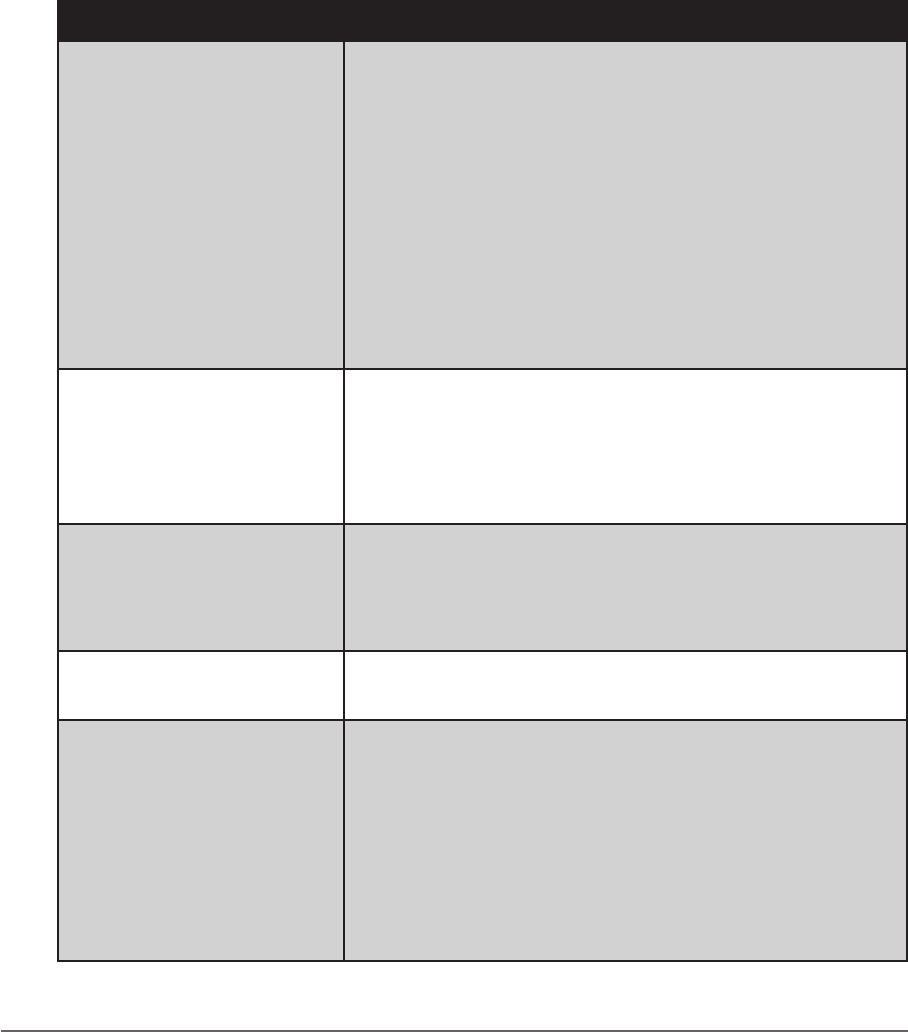
6-3Caring for the Tablet Computer
screen), recalibrate the touchscreen display (see “Calibrating the Screen”
on page 2-3).
Troubleshooting
When you encounter problems when using the Tablet Computer, try the
following troubleshooting tips rst to detect and solve the problem.
Many faults can also be cleared by removing the batteries and AC power
connections for a period of several seconds. Then re-install the batteries,
connect the AC power and then turn on the Tablet Computer again.
If problems persist, contact customer support.
Problem Solution
The battery is not
charging.
• Make sure the AC adapter is properly
connected.
• Make sure the battery is not too hot or too cold.
• Make sure the battery packs are installed
correctly.
• Make sure the battery terminals are clean.
• The Tablet Computer may have come from
an outdoor environment which exceeds the
charging ambient temperature. Wait a while for
the battery pack to reach the appropriate room
temperature, and it will start charging.
Nothing appears on the
screen.
• The Tablet Computer may be in sleep mode.
Press the power button to wake up the display.
• The brightness level may be too low. Increase
brightness (see “Adjusting Screen Brightness”
on page 2-11).
The screen suddenly
turns blank and the
power indicator goes off.
• Make sure the AC adapter is properly
connected.
• If using battery packs, the batteries may be
depleted, replace or charge the batteries.
I cannot use the wireless
LAN feature.
• Make sure that wireless LAN feature is turned
on.
Wireless LAN signal
quality is poor.
• The Tablet Computer may be out of range. Move
your Tablet Computer closer to the access point
or another wireless LAN device associated with
it.
• Check if your surroundings have interferences,
such as microwave ovens, cordless phones.
Move the Tablet Computer away from objects
causing interference.
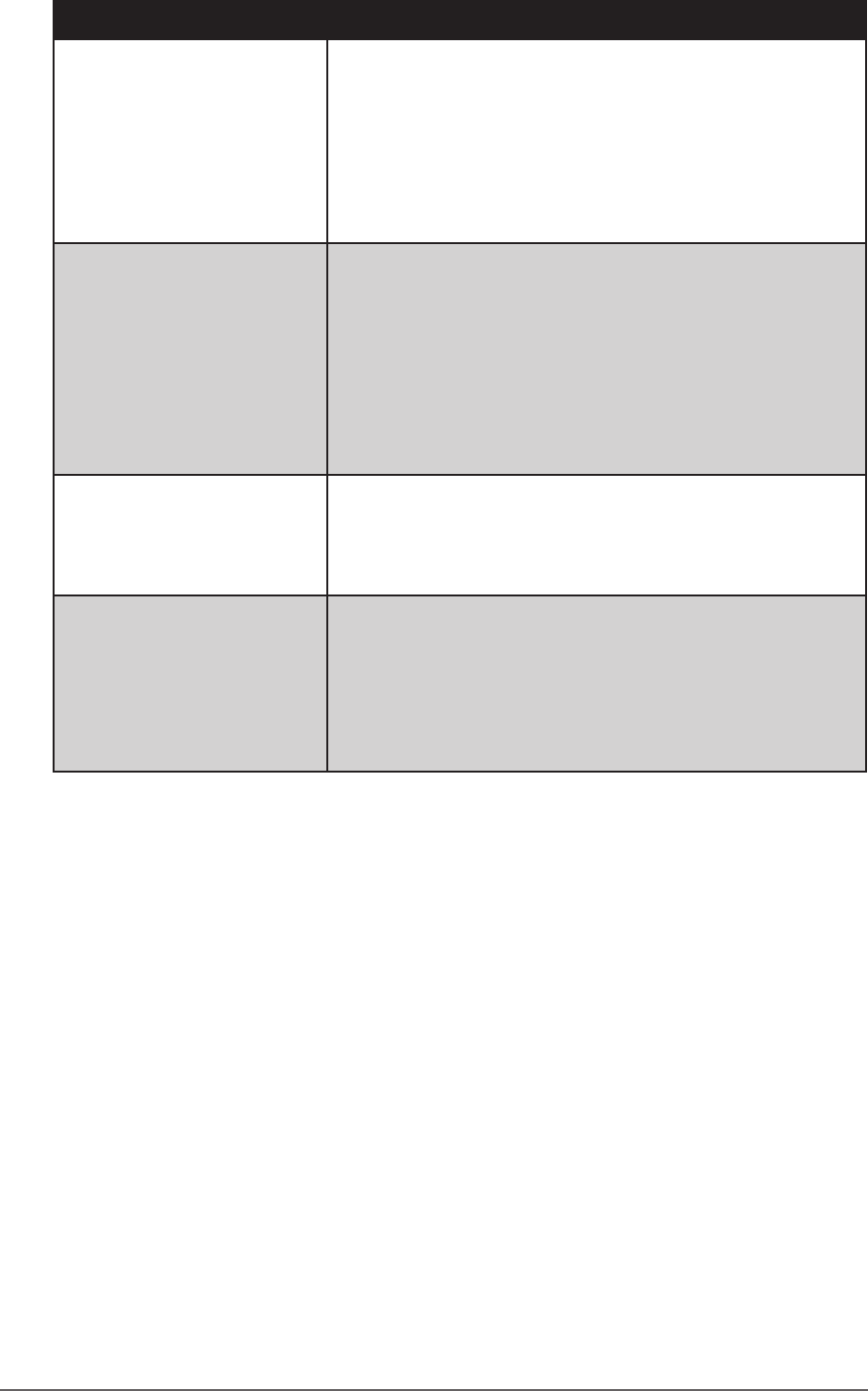
6-4 Caring for the Tablet Computer
Problem Solution
I cannot connect to
another wireless LAN
device.
• Make sure that wireless LAN feature is turned
on.
• Make sure that the SSID setting is the same for
every wireless LAN device in the network.
• Restart the Tablet Computer.
• Make sure the IP address or subnet mask
setting is correct.
I cannot connect to
another device with
Bluetooth.
• Make sure that both devices have Bluetooth
turned on.
• Make sure that the distance between the two
devices is within 10 meters and there are no
walls or large obstructions between the devices.
• Make sure that both devices are turned on and
are congured to be discoverable.
• Make sure that both devices are compatible.
No sound is produced. • Adjust the volume of the Tablet Computer (see
“Adjusting Volume” on page 2-11).
• If using an external audio device, make sure that
the cable is properly connected.
The Tablet Computer
fails to start up.
• Perform these steps in the following order:
a. Remove the batteries.
b. Disconnect the external power source.
c. Re-install the batteries.
d. Connect the external power source.
e. Try to restart again.
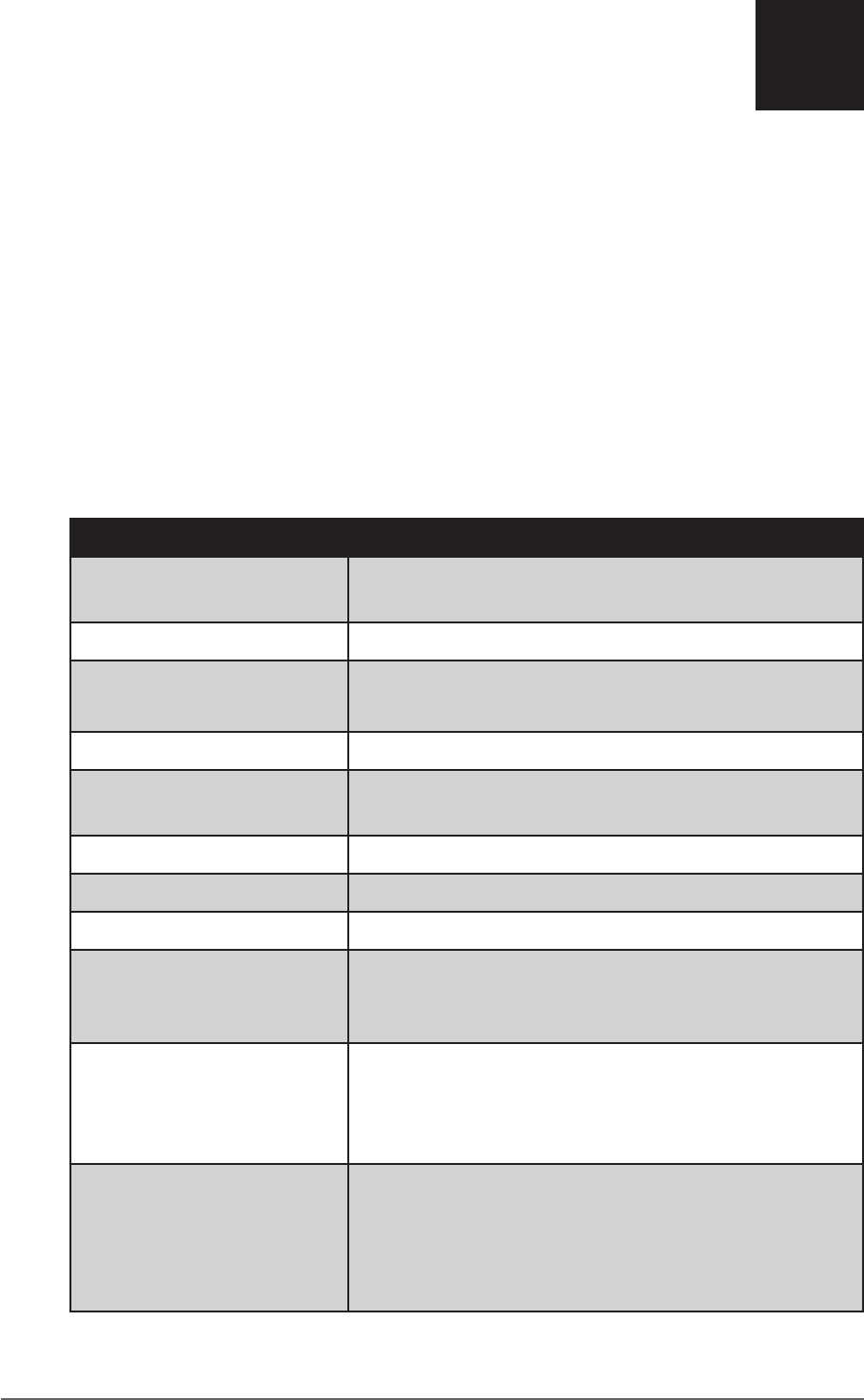
A-1Specications
APPENDIX A
Tablet Computer Specications
Technical Specications
Processor Intel® Atom N2600 1.6GHz
TDP 3.5W
BIOS • AMI BIOS
Chipset • Intel® NM10
• TDP 1.5W
Main Memory DDR3 SO-DIMM 4GB, single slot
Display • 7” TFT WSVGA 1024 x 600
• Projective Capacitive Touch Panel
Graphics • Intel® Atom GMA3600
HDMI Output • HDMI 1.3a compliant
Storage • mSATA 64 / 128 GB SSD
Connectivity
• WLAN: 801.11 a/b/g/n
• PAN: Bluetooth 4.0 HS, Class II
• WWAN: GSM/WCDMA/CDMA/CDMA2000
LED Status Indicator
• Power
• Battery
• WLAN
• WWAN
Interface
• Audio Jack x 1
• HDMI Type A x 1
• SIM Card x 1
• USB 2.0 Type A x 2
• Docking Connector x 1
Specications
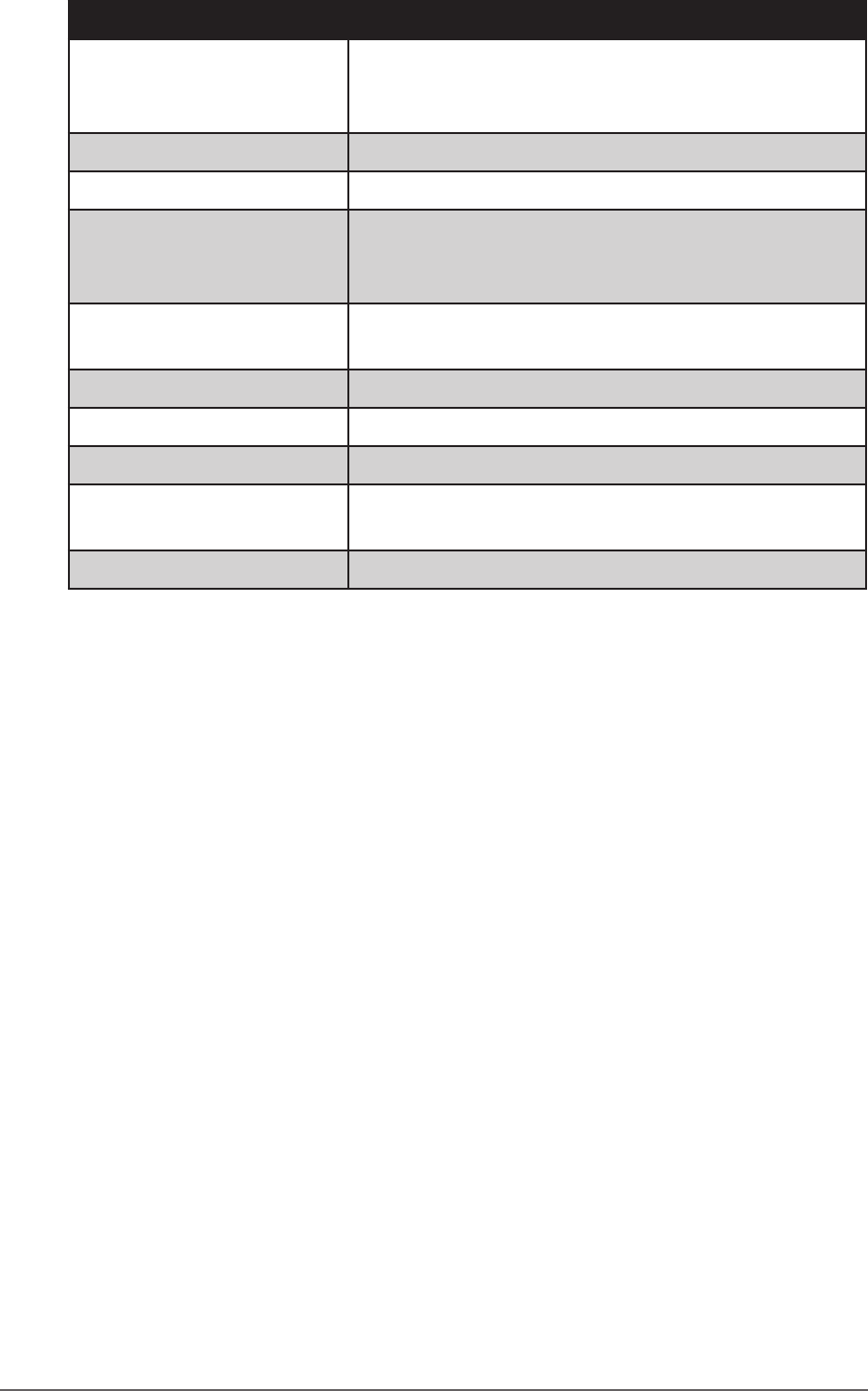
A-2 Specications
Technical Specications
Audio
• HD Audio
• Digital Microphone x 1
• Built-in Speaker x 1
Input Device Capacitive Touch Panel
Power Management ACPI 3.0 Supported
Battery Life
• Li-Ion 2 cells, 7.5 V / 3000 mAh x 2
• 8+ hours battery life
• Built-in Gauge IC
AC Adapter Output: 12V DC, 5A, 60W
Input: 100 ~ 240V AC, 50 ~ 60Hz Universal
Heat Dissipation Fanless design
Dimensions (WxHxD) 245 x 156 x 27.5 mm
Weight < 1.2 Kg (including standard battery x 2)
Regulation • EMI: FCC, CE, C-tick
• Safety: TUV NRTL, CE, C-tick
Windows Certication • Windows 7 Professional 32bit

B-1Regulatory Information
APPENDIX B
This appendix provides regulatory statements and safety notices about your
Tablet Computer.
NOTE: Marking labels located on the exterior of your Tablet Computer indicate the regulations that
your model complies with. Check the marking labels and refer to the corresponding statements in this
appendix. Some notices apply to specic models only.
Regulatory Information
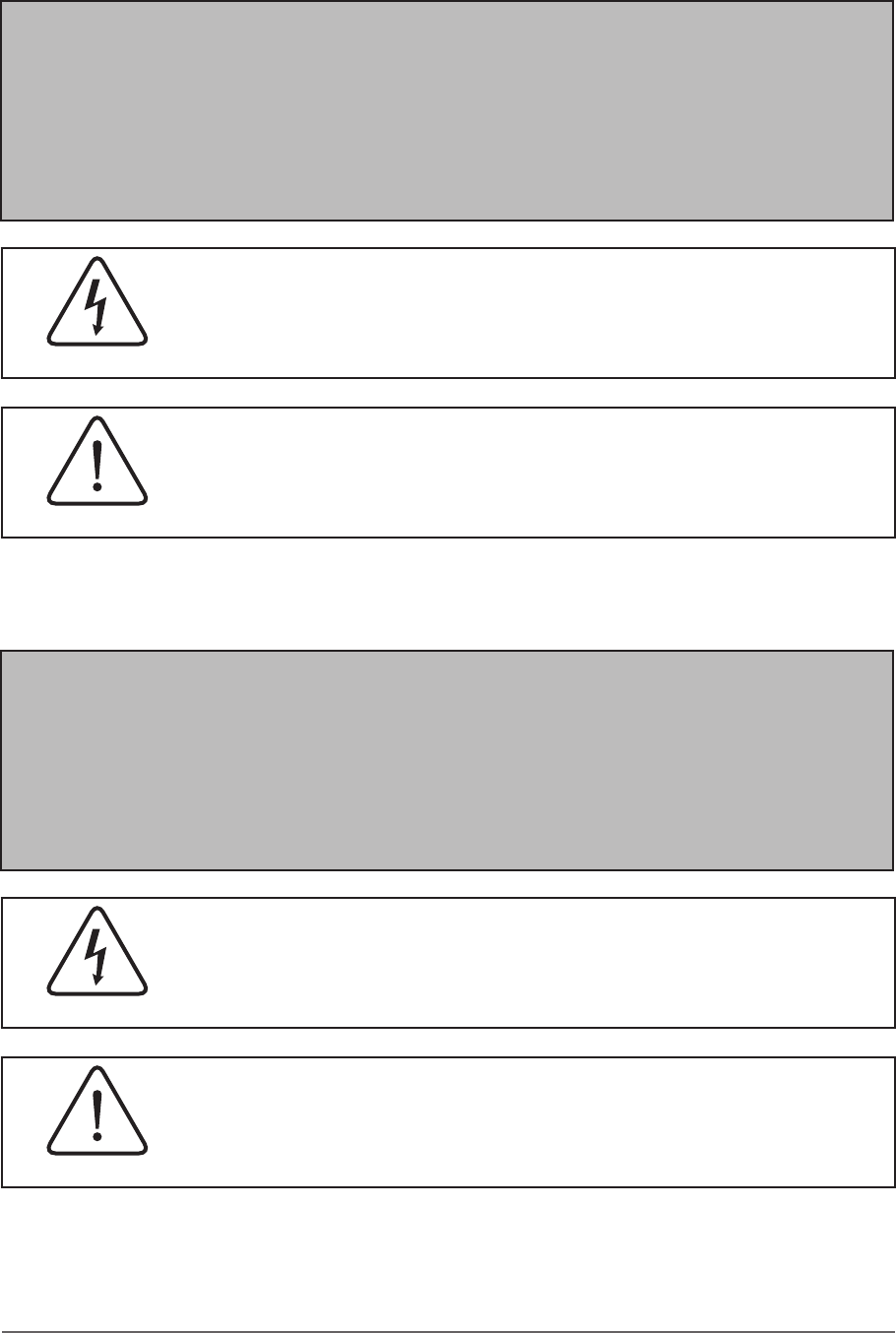
B-2 Regulatory Information
Important Information
WARNING: To reduce the risk of re or electric shock, do not expose this
appliance to rain or moisture. MAKE SURE the power cord is UNPLUGGED
FROM THE WALL OUTLET IF IT WILL NOT BE USED FOR AN EXTENDED
PERIOD OF TIME. To completely disengage power from the unit, BE SURE
TO UNPLUG THE POWER CORD FROM THE AC OUTLET. Do not remove
the back cover or any internal parts. Contact qualied personnel if repairs are
necessary.
SA1965
ELECTRICAL SAFETY WARNING
Used for instructions intended to alert the user to the risk of a
fatal electric shock or serious injury in case of incorrect use of the
unit.
SA1966
WARNING
Used for instructions intended to alert the user to the risk of death
or serious injury in case of incorrect use of the unit.
ATTENTION: Pour réduire le risque d’incendie ou de choc electrique ne pas
exposer l’appareil à la pluie ou à l’humidité FAIRE le cordon électrique est
DÉBRANCHÉ DE LA PRISE MURALE DANS UN DELAI DE PROLONGER
INACTIVITÉ. De se désengager totalement LE POUVOIR DE L’UNITE, S’IL
VOUS PLAÎT DEBRANCHER LE CORDON D’ALIMENTATION DE LA PRISE
AC. NE PAS Romove le capot arrière, pas de PIÈCES À L’INTÉRIEUR.
Contactez un personnel qualié S’il faut le réparer.
SA1965
ELECTRIQUE AVERTISSEMENT
Sert aux instructions destin es alerter l’utilisateur d’un CHOC
ÉLECTRIQUE mortel ou de blessure grave en cas d’utilisation
incorrecte de l’unit.
SA1966
AVERTISSEMENT
Sert aux instructions destin es alerter l’utilisateur d’un risque
mortel ou de blessure grave en cas d’utilisation incorrecte de
l’unit .

B-3Regulatory Information
Safety Information (EN)
Follow and adhere to all warnings and instructions on the screen. For your
safety, please read all safety and operating instructions before using Yuma 2
Tablet Computer. Keep this manual for future reference.
1. Carefully read all recommendations and precautions for use before using
this product.
2. All recommendations and precautions for use should be retained so that
they can be referred to necessary.
3. Read and be sure to understand all warnings listed in the precautions.
4. Follow all operating precautions when using this product.
5. Use only a soft cloth to clean this product.
6. Do not block any ventilation openings. Do not place the product against a
wall or in an enclosed space as doing so might impede the ow of cooling
air.
7. Do not place the product near any heat sources such as radiators, warm
air intakes, stoves or other heat-generating devices (including ampliers or
other heat producing equipment).
8. Do not disregard the safety that a polarized or grounded connection can
provide. A polarized connection consists of two plugs, one of which is
larger than the other. A grounded connection has two blades and a third
one that is grounded. If the main plug provided cannot be inserted into
your outlet, consult an electrician to replace your obsolete outlet.
9. Protect the power cord from being crushed or pinched, particularly in the
area of the plugs, any receptacles used, and the point of exit from the
apparatus. Do not break off the ground pin of the power cord.
10. Use only accessories specied by the manufacturer.
11. Unplug this apparatus during lightning storms or when it is not being used
for long periods.

B-4 Regulatory Information
Safety Information (FR)
Suivez et respectez tous les avertissements et instructions gurant sur l’écran.
Pour votre sécurité, s’il vous plaît lire toutes les consignes de sécurité et de
fonctionnement avant d’utiliser le moniteur. Gardez ce manuel pour référence
future.
1. Lire avec attention toutes les recommandations et precautions d’emploi
avant d’utiliser ce produit.
2. Toutes les recommandations et précautions d’emploi doivent être
conservées an de pouvoir s’y reporter si nécessaire.
3. Lire et comprendre tous les avertissements énumérés dans les
précautions d’emploi.
4. Suivre toutes les précautions d’emploi pour utiliser ce produit.
5. Utiliser exclusivement un chiffon doux pour nettoyer ce produit.
6. Ne bloquér aucune ouverture de ventilation. Ne pas placer le produit tout
contre un mur ou dans une enceinte fernée, cela gênerait le ux d’air
nécessaire au refroidissement.
7. Ne pas placer le produit près de toute source de chaeur telle que
radiateurs, arrivées d’air chaud, fourneaux ou autres appareils générant
de la chaleur (incluant les amplicateurs producteurs de chaleur) .
8. Ne pas négliger la sécurité que procure un branchement polarisé ou avec
raccordement à la terre, Un branchement polarisé comprend deux ches
dont l’une est plus large que l’autre. Un branchement à la terre comprend
deux ches plus une troisième reliée à la terre. Si la che secteur fournie
ne s’insert pas dans votre prise de courant. consulter un ‘électricien an
de remplacer votre prise obsolète.
9. Protéger le cordon d’alimentation de tout écrasement ou pincement,
particulièrement au niveau des ches, des réceptacles utilisés et à
l’endroit de sortie de l’appareil. Ne pas casser la che de terre du cordon
d’alimentation.
10. Utiliser uniquement les accessoires spéciés par le constructeur.
11. Débrancher cet appareil lors d’orages ou s’il n’est pas utilize pendant une
longue période.

B-5Regulatory Information
About the Batteries
Nordic Lithium Cautions (for lithium-ion batteries)
CAUTION!
Danger of explosion if battery is incorrectly replaced. Replace only with the
same or equivalent type recommended by the manufacturer. Dispose of used
batteries according to the manufacturer’s instructions. (English)
ATTENTION!
Il y a danger d’explosion s’il y a remplacement incorrect de la batterie.
Remplacer uniquement avec une batterie du mêre type ou d’un type équivalent
recommandé par le constructeur. Mettre au rebut les batteries usagées
conformément aux instructions du fabricant. (French)
About the Adapter
• Use only the supplied AC adapter (Rating: Input DC 12V, 5.0A). Use of
another type of AC adapter will result in malfunction and/or danger.
• Do not use the adapter in a high moisture environment. Never touch the
adapter when your hands or feet are wet.
• Allow adequate ventilation around the adapter when using it to operate the
device or charge the battery. Do not cover the AC adapter with paper or
other objects that will reduce cooling. Do not use the AC adapter while it is
inside a carrying case.
• Connect the adapter to a proper power source. The voltage requirements
are found on the product case and/or packaging.
• Do not use the adapter if the cord becomes damaged.
• Do not attempt to service the unit. There are no serviceable parts inside.
Replace the unit if it is damaged or exposed to excess moisture.

B-6 Regulatory Information
FCC Regulations
This device complies with part 15 of the FCC Rules. Operation is subject to the
following two conditions: (1) This device may not cause harmful interference,
and (2) this device must accept any interference received, including interference
that may cause undesired operation.
This device has been tested and found to comply with the limits for a Class B
digital device, pursuant to Part 15 of the FCC Rules. These limits are designed
to provide reasonable protection against harmful interference in a residential
installation. This equipment generates, uses and can radiate radio frequency
energy and, if not installed and used in accordance with the instructions, may
cause harmful interference to radio communications. However, there is no
guarantee that interference will not occur in a particular installation. If this
equipment does cause harmful interference to radio or television reception,
which can be determined by turning the equipment off and on, the user is
encouraged to try to correct the interference by one or more of the following
measures:
• Reorient or relocate the receiving antenna.
• Increase the separation between the equipment and receiver.
• Connect the equipment into an outlet on a circuit different from that to which
the receiver is connected.
• Consult the dealer or an experienced radio/TV technician for help.
Changes or modications not expressly approved by the party responsible for
compliance could void the user‘s authority to operate the equipment.
Operation on the 5.15-5.25GHz frequency band is restricted to indoor use only.
The FCC requires indoor use for the 5.15-5.25GHz band to reduce the potential
for harmful interference to co-channel Mobile Satellite Systems. Therefore, it
will only transmit on the 5.25-5.35 GHz, 5.47-5.725 GHz and 5.725 –5.850 GHz
band when associated with an access point (AP).

B-7Regulatory Information
RF Exposure Information (SAR)
This device is compliance with SAR for general population /uncontrolled
exposure limits in ANSI/IEEE C95.1-1999 and had been tested in accordance
with the measurement methods and procedures specied in OET Bulletin 65
Supplement C.
This equipment complies with FCC RF radiation exposure limits set forth for an
uncontrolled environment. This device was tested for operations with the device
contacted directly to the human body to the back side of the EUT. To maintain
compliance with FCC RF exposure compliance requirements, avoid direct
contact to the transmitted antenna during transmitting.
IC Regulations
This device complies with Industry Canada license-exempt RSS standard(s).
Operation is subject to the following two conditions:
(1) this device may not cause interference, and
(2) this device must accept any interference, including interference that may
cause undesired operation of the device.
Le présent appareil est conforme aux CNR d’Industrie Canada applicables
aux appareils radio exempts de licence. L’exploitation est autorisée aux deux
conditions suivantes:
(1) l’appareil ne doit pas produire de brouillage, et
(2) l’utilisateur de l’appareil doit accepter tout brouillage radioélectrique subi,
même si le brouillage est susceptible d’en compromettre le fonctionnement.”
This Class B digital apparatus complies with Canadian ICES-003
Cet appareil numérique de la classe B est conforme à la norme NMB-003 du
Canada.
The device could automatically discontinue transmission in case of absence of
information to transmit, or operational failure. Note that this is not intended to
prohibit transmission of control or signaling information or the use of repetitive
codes where required by the technology.

B-8 Regulatory Information
The device for the band 5150-5250 MHz is only for indoor usage to reduce
potential for harmful interference to co-channel mobile satellite systems; the
maximum antenna gain permitted (for devices in the bands 5250-5350 MHz and
5470-5725 MHz) to comply with the e.i.r.p. limit; and The maximum antenna
gain permitted (for devices in the band 5725-5850 MHz) to comply with the
e.i.r.p. limits specied for point-to-point and non point-to-point operation as
appropriate, as stated in section A9.2(3). In addition, High-power radars are
allocated as primary users (meaning they have priority) of the band 5250-5350
MHz and this radar could cause interference and/or damage to LE-LAN devices.
The County Code Selection feature is disabled for products marketed in the US/
Canada. For product available in the USA/ Canada markets, only channel 1~11
can be operated. Selection of other channels is not possible.
Important Note
IC Radiation Exposure Statement
This EUT is compliance with SAR for general population/uncontrolled exposure
limits in IC RSS-102 and had been tested in accordance with the measurement
methods and procedures specied in IEEE 1528.
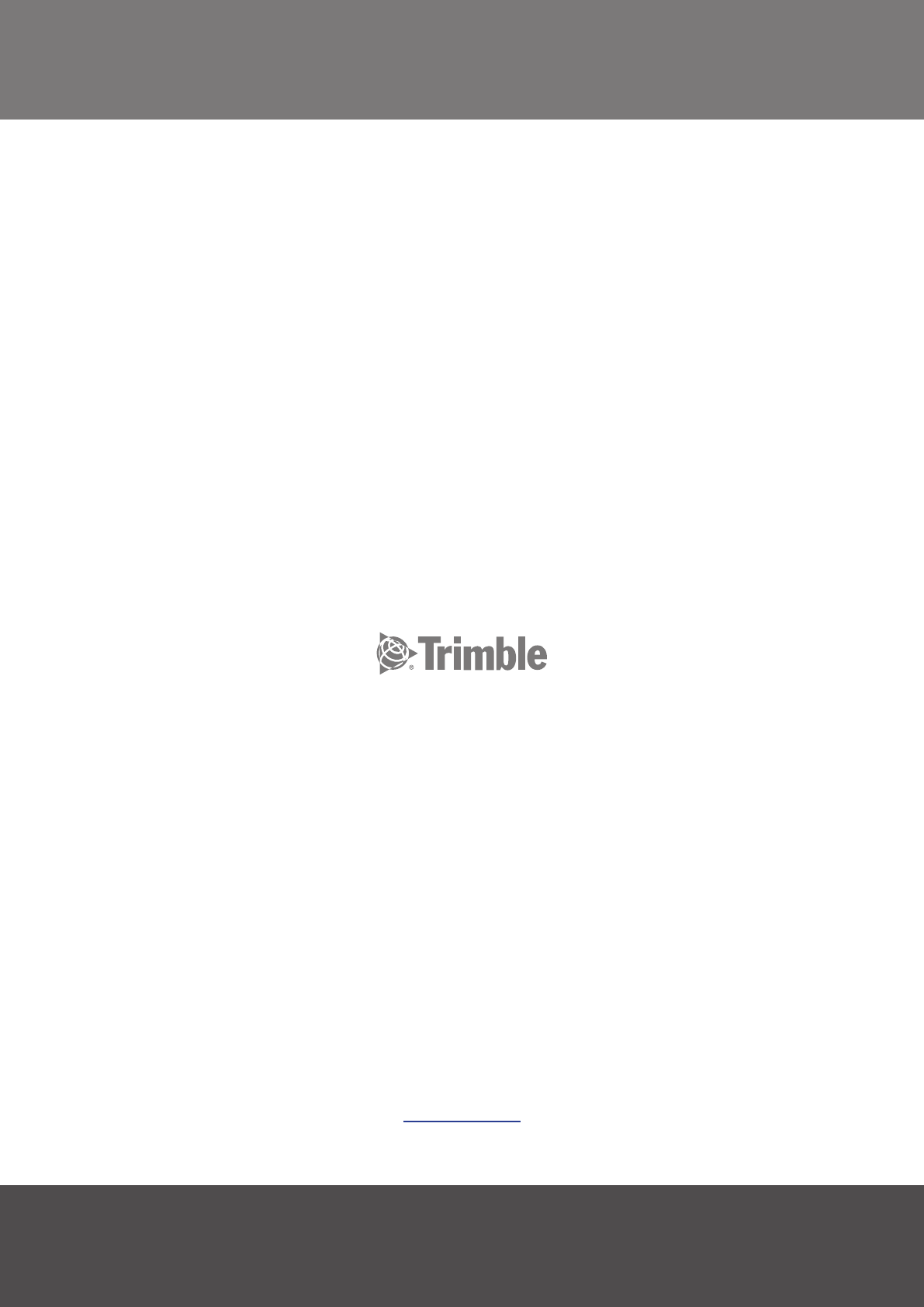
www.trimble.com
© 2012 Trimble Navigation Limited. All rights reserved.
This product is protected by US and international copyright, trademark and patent law.